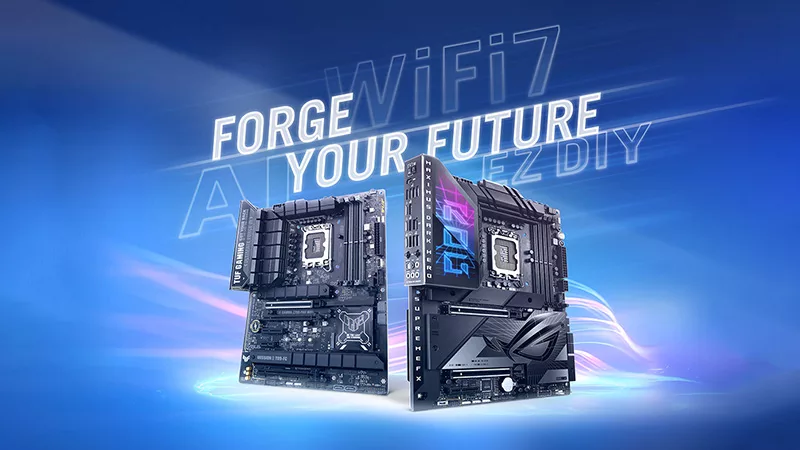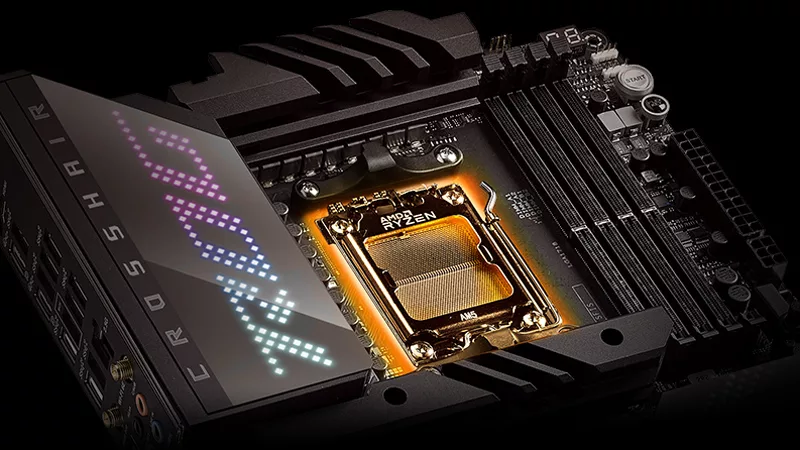Z590 motherboard guide: ROG Maximus XIII and ROG Strix bring power to the core
Intel’s 11th Gen Core CPUs, code-named Rocket Lake, bring a cutting-edge microarchitecture to desktop PCs across up to eight processing cores and 16 threads. Per-core performance improvements ranging up to 19% over the prior CPU generation, available Xe integrated graphics processors for easy accelerated media encoding, and 20 lanes of PCI Express 4.0 connectivity for the latest SSDs and graphics cards make 11th Gen Core CPUs a thoroughly modern nerve center for enthusiast PCs. New CPUs beget new chipsets, and Intel is introducing the Z590 platform alongside 11th Gen Core CPUs. We’re tapping everything that the Z590 chipset has to offer across ROG Maximus XIII and ROG Strix families of motherboards. This Z590 motherboard guide helps you find the right foundation for your own build, whether you’re after the no-holds-barred, no-compromise approach of the ROG Maximus XIII series or the stylish power of the ROG Strix boards.
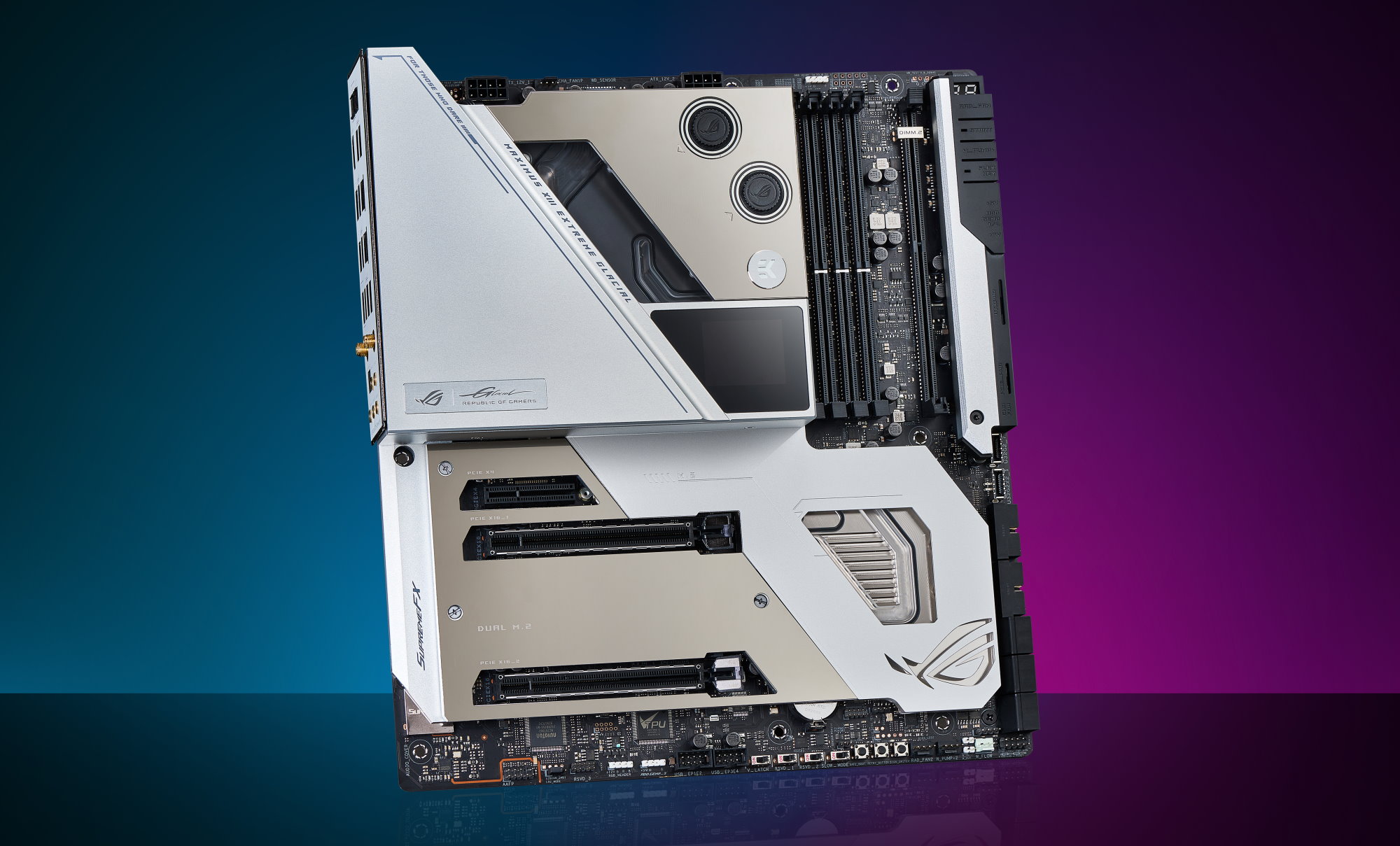
Builders who want a motherboard compatible with all the best features of 11th Gen Intel Core CPUs and don’t need the CPU core overclocking capabilities of the Z590 chipset can instead take a look at our equally fresh H570 and B560 motherboard families. Stick around to learn more about all of the cutting-edge goodness we’ve crammed into our Z590 motherboard lineup.
Thoroughly next-gen
The Z590 chipset brings myriad peripheral and network connectivity improvements. The fun starts with Thunderbolt 4 support, which we included across the entire lineup. Thunderbolt 4 guarantees 40Gbps of peripheral bandwidth with compatible devices and also provides support for the next-gen USB4 protocol, all of which is baked into one USB Type-C physical port.
Thunderbolt 4 communicates across universal, reversible USB Type-C cables running up to two meters in length, and it ensures secure operation with connected devices by mandating protected access to system memory. Select ROG and ROG Strix boards include Thunderbolt 4 ports right on the back panel, while others include an onboard header for an optional expansion card.
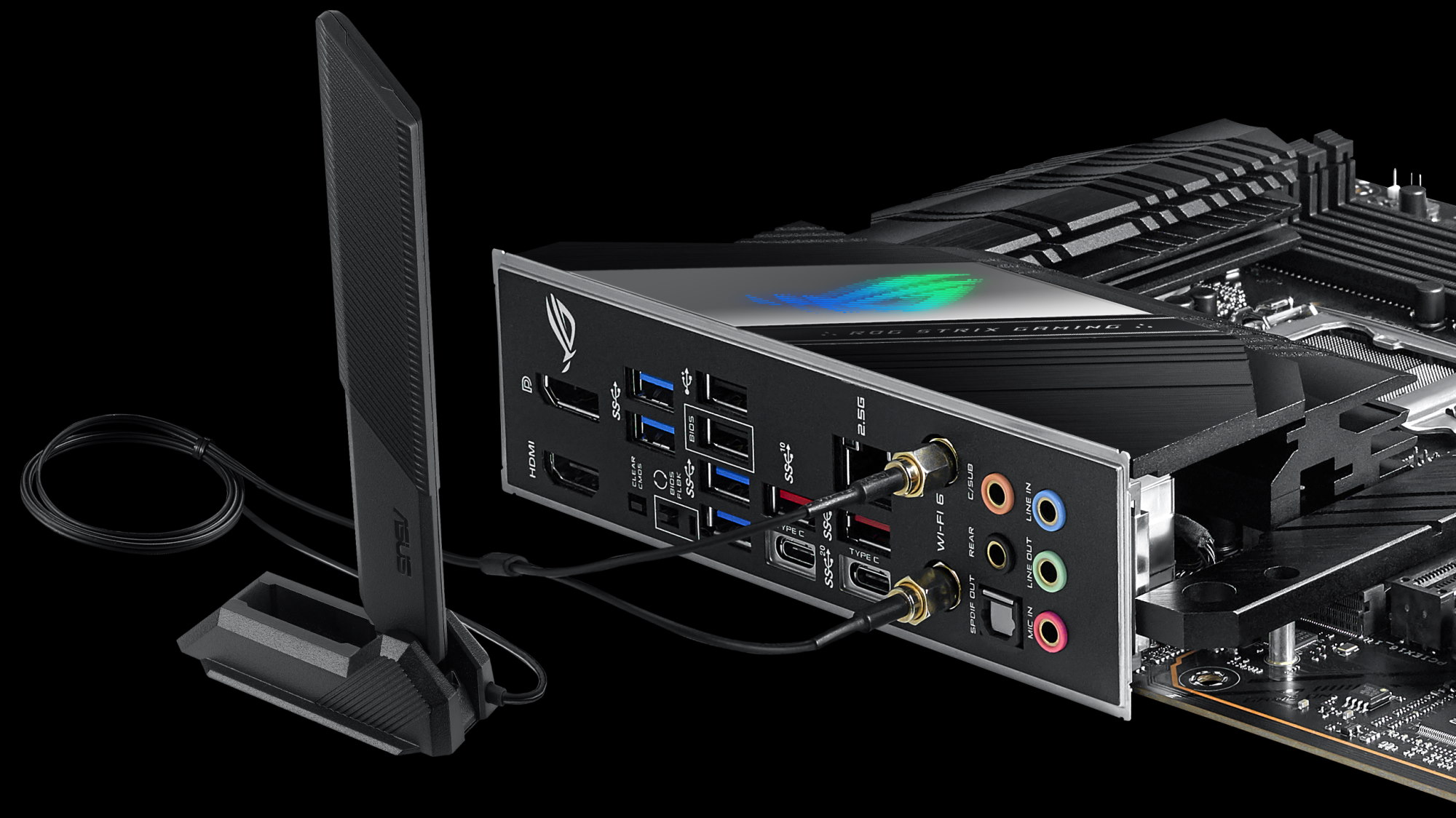
USB Gen 3.2 2×2 connectivity and its 20Gbps of bandwidth come standard on Z590, and we’ve deployed it across the lineup, too. Every board includes at least one such port at the back, and most have front-panel headers for more. External NVMe SSDs can already push data rates well past 10Gbps, so these new ports are ready for those drives and other ultra-high-speed peripherals still to come.
The Z590 chipset supports 2.5 Gigabit Ethernet controllers, and as a result, nearly every board in the lineup gets wired for 2.5Gbps at a minimum. If you prefer to go wireless, WiFi 6 support is likewise widespread for fast and efficient performance on compatible networks, even in crowded wireless airspace. Our fanciest Z590 boards go one step further with Intel AX210 WiFi 6E controllers that put the wide swath of soon-to-be-opened 6GHz spectrum to good use for extra bandwidth, lower interference, and improved signal stability.
Blazing performance, frigid temperatures
Firing up a lot of cores at the stratospheric clock speeds available from 11th Gen Core CPUs requires no small amount of power, and our Z590 motherboards are prepared to deliver the juice. Every single board in the lineup gets a VRM upgrade, ranging up to a massive 18+2 configuration on the ROG Maximus XIII Extreme.
Vast reserves of power are no good if motherboards can’t deliver it without overheating, so our Z590 boards’ heatsinks are significantly upsized. Our engineers are always on the lookout for new ways to improve onboard cooling, and this time around, they turned their attention to the unassuming I/O shield and made it part of the VRM cooling setup for added surface area. These higher-mass heatsinks are as much as 1.7x heavier and offer up to 1.6x as much surface area compared to the Z490 lineup.
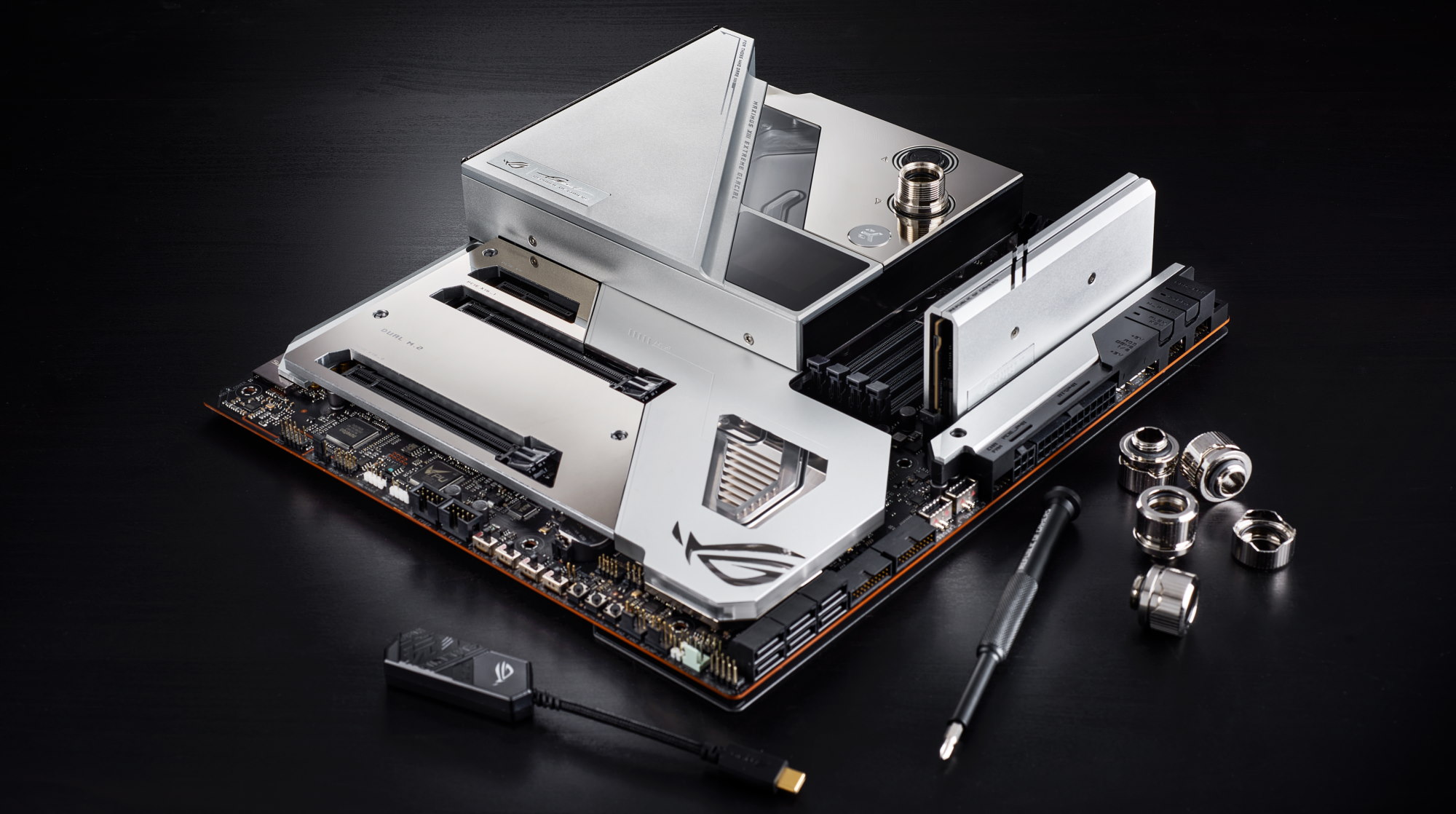
SSDs can get pretty toasty, too. Conventional heatsinks only cover the top side of a drive, leaving plenty of bare circuit board to be cooled by the whims of case airflow. To fully cool each M.2 SSD, we altered the design of our heatsink system to include a backplate under the drive to more efficiently whisk heat away. This new design is present across our ROG Maximus XIII line and in the majority of ROG Strix models.
Speaking of M.2 devices, we know that builders hate dealing with tiny, easily lost M.2 screws. We’ve designed a new Q-Latch system that lets you secure an M.2 SSD with nothing more than your fingertips. This stress-reducing feature is available on most ROG Strix models.
AI powers the future
PC builders love to tune their systems so that everything is just right. They want high CPU clock speeds, low ping times, and agreeable noise levels. Tuning each and every parameter in a modern PC’s firmware takes valuable time, and getting perfect results can be rewarding, but that’s time you could spend gaming or creating. Thanks to the rise of AI-powered technologies, our Z590 motherboards can do much of this hard work for you.
Many enthusiasts know the familiar rhythm of overclocking: enter the UEFI, bump the CPU clock speeds a little higher, test, and add voltage if it crashes. Repeat until more voltage no longer helps. AI Overclocking technology offers a better way. Working from a database of performance profiles that we glean from hundreds of individual CPUs, AI Overclocking can intelligently boost your CPU’s single- and multi-core clock speeds while constantly monitoring stability, system temperatures, and cooling performance to maintain an ideal overclock over time. It requires just one click to enable, and our experience has shown that it gets you results within a hair’s breadth of time-consuming manual overclocking.
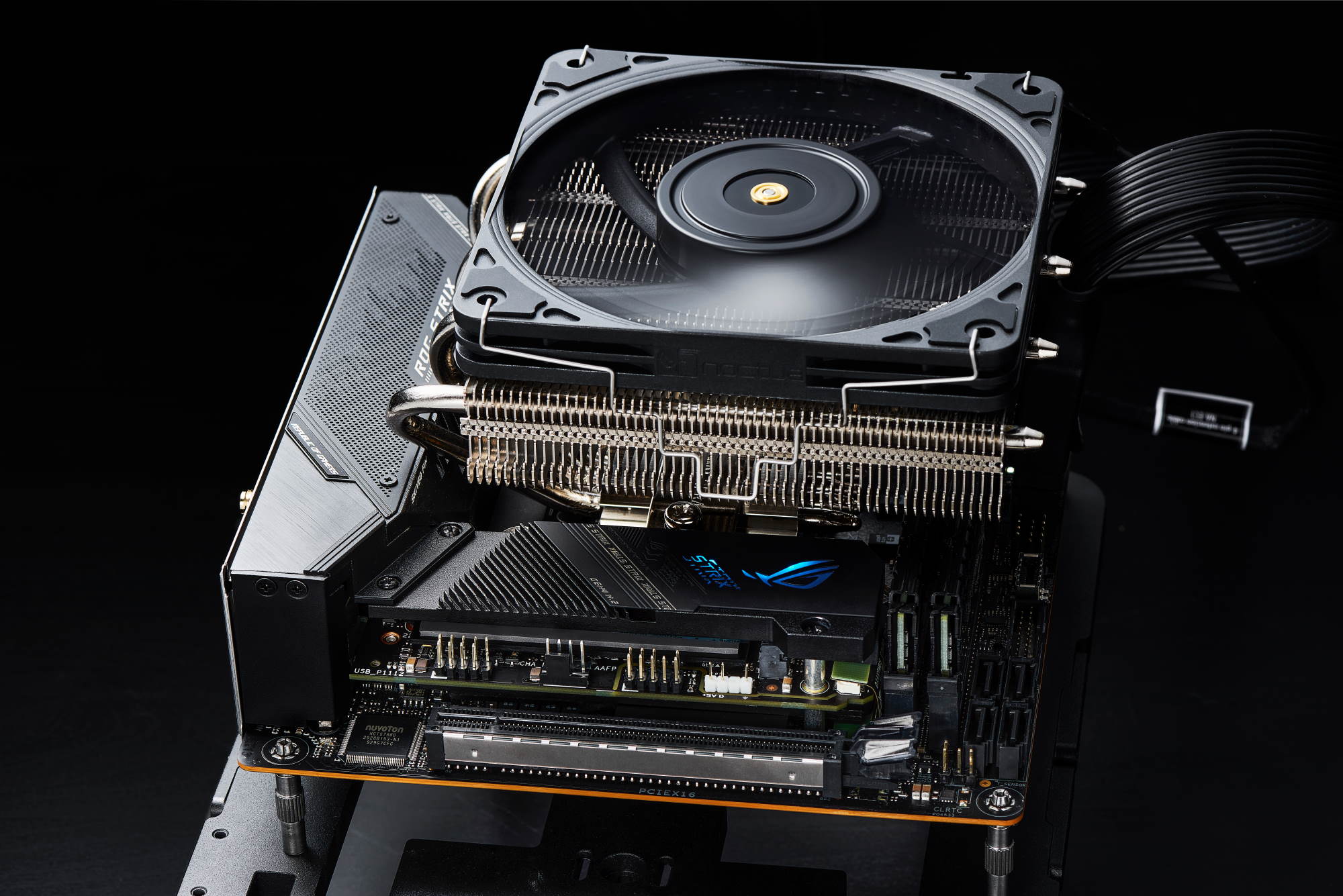
Meanwhile, AI Cooling ensures your PC is as quiet as it can be. Working in tandem with our Q-Fan controls, AI Cooling will dial down fan speeds when possible while keeping the CPU at a consistent temperature. This technology is present on ROG Maximus XIII and ROG Strix boards.
Our AI Noise Cancelation technology got a significant boost this time around. Not only does it filter keyboard noise and background chatter from your own mic’s input so your co-workers or teammates can hear you better, it now does the same to the signals you hear from everybody else. No more struggling to hear your teammates over barking dogs, crying babies, or noisy neighbors while you’re trying to focus on the objective. This feature uses only a small slice of CPU resources. Yes, CPU. We purposely avoid any extra GPU load to keep all of its power available for the highest possible frame rates.
Finally, AI Networking powers our GameFirst VI utility’s real-time traffic monitoring and prioritization. This feature draws from a comprehensive database of application network activity profiles and cross-references that data with your current network activity to prioritize the most important traffic at all times, all without annoying manual intervention.
Hail HydraNode
Even the best heatsinks can’t do their job without airflow, and contemporary builds employ plenty of fans or even liquid cooling pumps to move heat away from key components. Beyond our usual loadouts of hybrid fan headers across the lineup, select Z590 boards’ headers employ a new technology we call HydraNode. This ingenious feature lets you connect as many as three fans to one fan header using an off-the-shelf splitter, but unlike with older PWM headers, HydraNode still gives you full control and monitoring of each one—a perfect scenario for huge cases or complex liquid cooling setups.
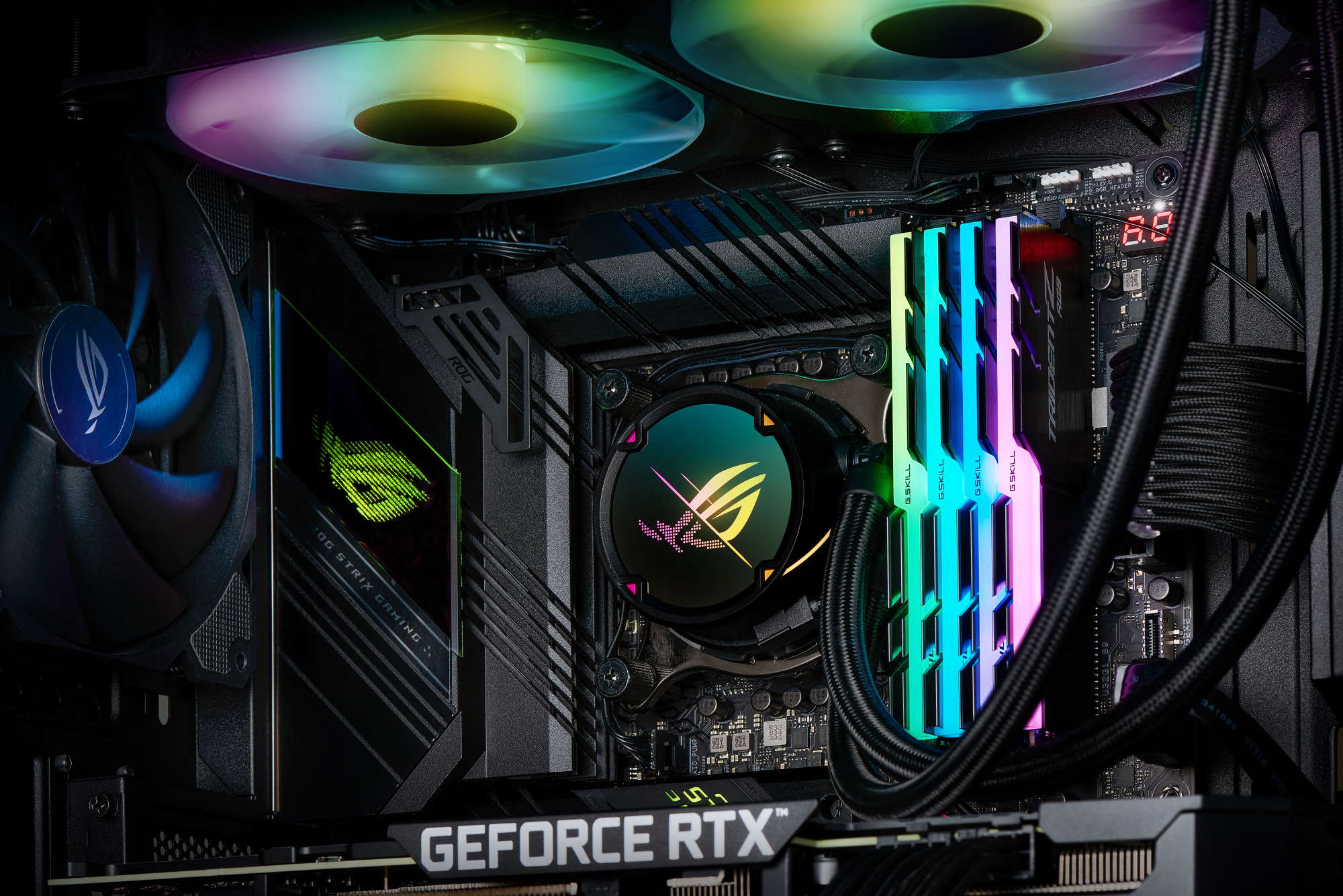
HydraNode control is fully integrated into our Fan Xpert 4 control panel and offers handy information that you can’t get from traditional PWM headers, like each connected fan’s model name and the number of power-on hours it’s logged. We’ve already teamed up with cooling luminaries SilverStone and BitFenix to build HydraNode-compatible fans, and you can expect more with support for this unique technology soon. No matter what wicked cooling setup you can dream up, our Z590 motherboards can make it reality.
Dulcet tones and rowdy rumbles
Not everything in a 2021 motherboard has to be about Watts, Celsius, and Hertz. The audio circuitry is an often-underrated part. Sound is a key component in movies and games, and a powerful audio subsystem can provoke a visceral reaction that’s hard for even the most astounding graphics to replicate.
That’s why we’ve upgraded the audio chips on our higher-end boards. Most of the ROG Maximus XIII lineup combines the new SupremeFX ALC4082 codec with an ESS Sabre ESS9018Q2C front-panel DAC for pristine audio quality through audiophile headphones. ROG Strix models employ a new SupremeFX ALC4080 codec paired with a Savitech SV3H712 dedicated front-panel headphone amplifier. Whichever board you choose, your music, movies, and games will all benefit from immersive, high-fidelity audio.
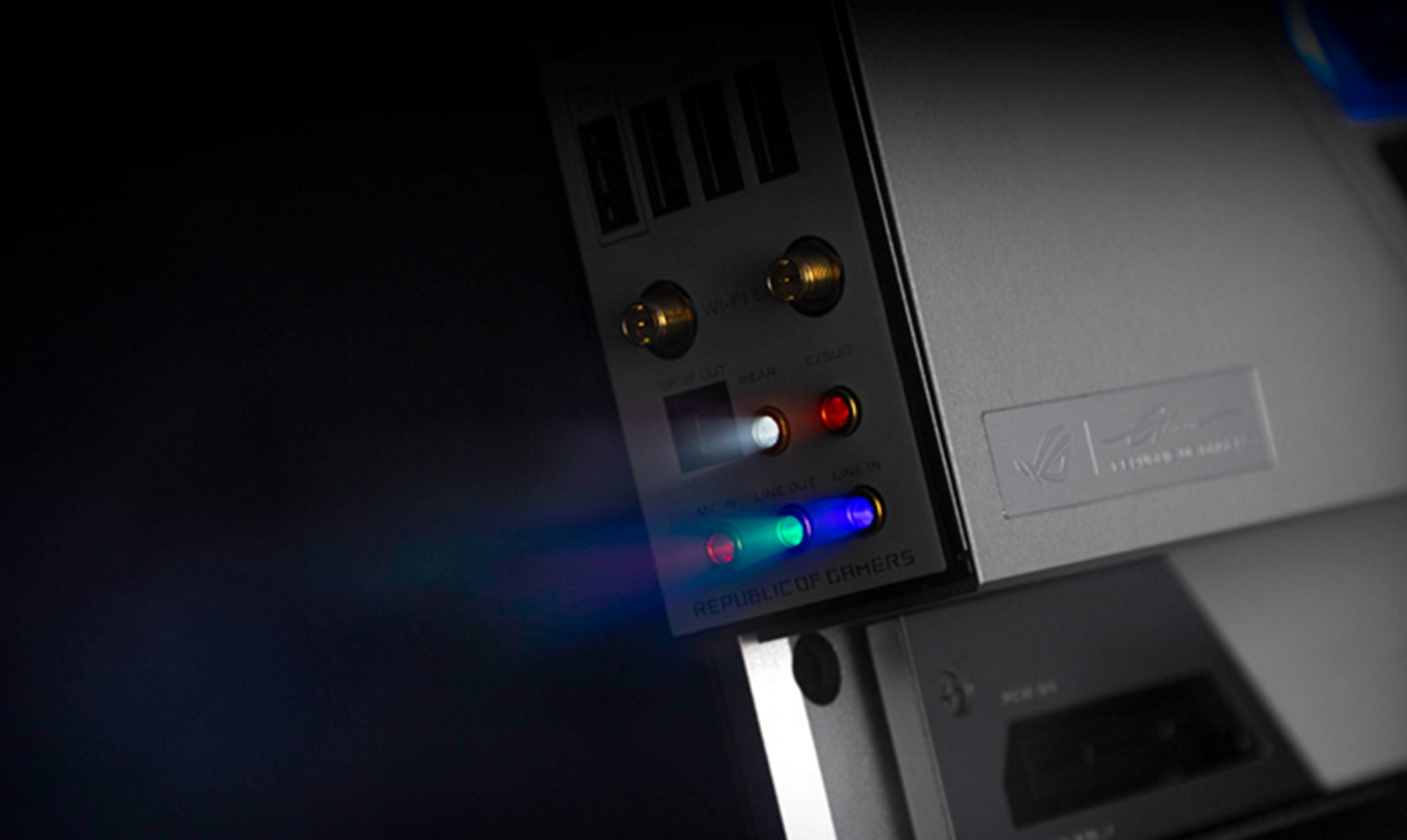
Our duo of Maximus XIII Extreme boards turns this obsession with sound quality up yet another notch. These boards both include the new ROG Clavis, a USB-C outboard DAC inspired by our highest-end gaming headsets. It uses four separate ESS converters to maximize signal-to-noise ratios and minimize any electrical interference from components inside a PC case. For exceedingly sensitive and discerning ears, the ROG Clavis brings our most advanced audio architecture to any headset or headphones.
A new sense of style
The refinements of our Z590 motherboards don’t focus just on hardware features. The ROG Maximus XIII Extreme Glacial elevates elite custom PC builds with its striking silver aesthetic and full-coverage integrated waterblock. ROG and ROG Strix motherboards got subtle tweaks to their cybernetic-inspired styling. Builders into the ultra-clean look of white components will find a ready companion in the ROG Strix Z590-A Gaming.
Graphics on the motherboard itself can only take you so far when it comes to customization. You need the proper mood lighting to complete the package, and we’ve got you covered. The Z590 lineup all include a minimum of four RGB LED strip headers. That count includes larger numbers of Gen 2 addressable RGB headers that offer per-LED light control, faster effects, and auto-detection functionality with presets.
The ROG Fan Controller bundled with ROG Maximus XIII Extreme boards offers six extra Gen 2 addressable RGB headers beyond those already on the board. We figure builders who pick the greatest boards will also want to run the most impressive light shows. Even across the wildest lighting setups, our proven Aura software always remains in command through our Armoury Crate software.
Attention to detail comes standard
When setting up a machine with one of our motherboards, you’ll encounter many small touches that make your life a lot simpler. BIOS FlashBack™, available on many of our Z590 boards, lets you easily flash a new firmware without a processor or any RAM handy—just plug a USB stick in the marked port, hold a button, and go. This is quite handy when a new CPU line comes out, or just as a lifesaver in case your overclocking efforts get far out of hand. Our Armoury Crate software integrates overclocking, system monitoring, and Aura Sync controls all in one place for easing setup and maintenance. SafeSlot metal-reinforced PCIe x16 slots are prevalent across the Z590 offerings, too. As always, our award-winning UEFI makes both baseline and advanced system settings simple to manage.
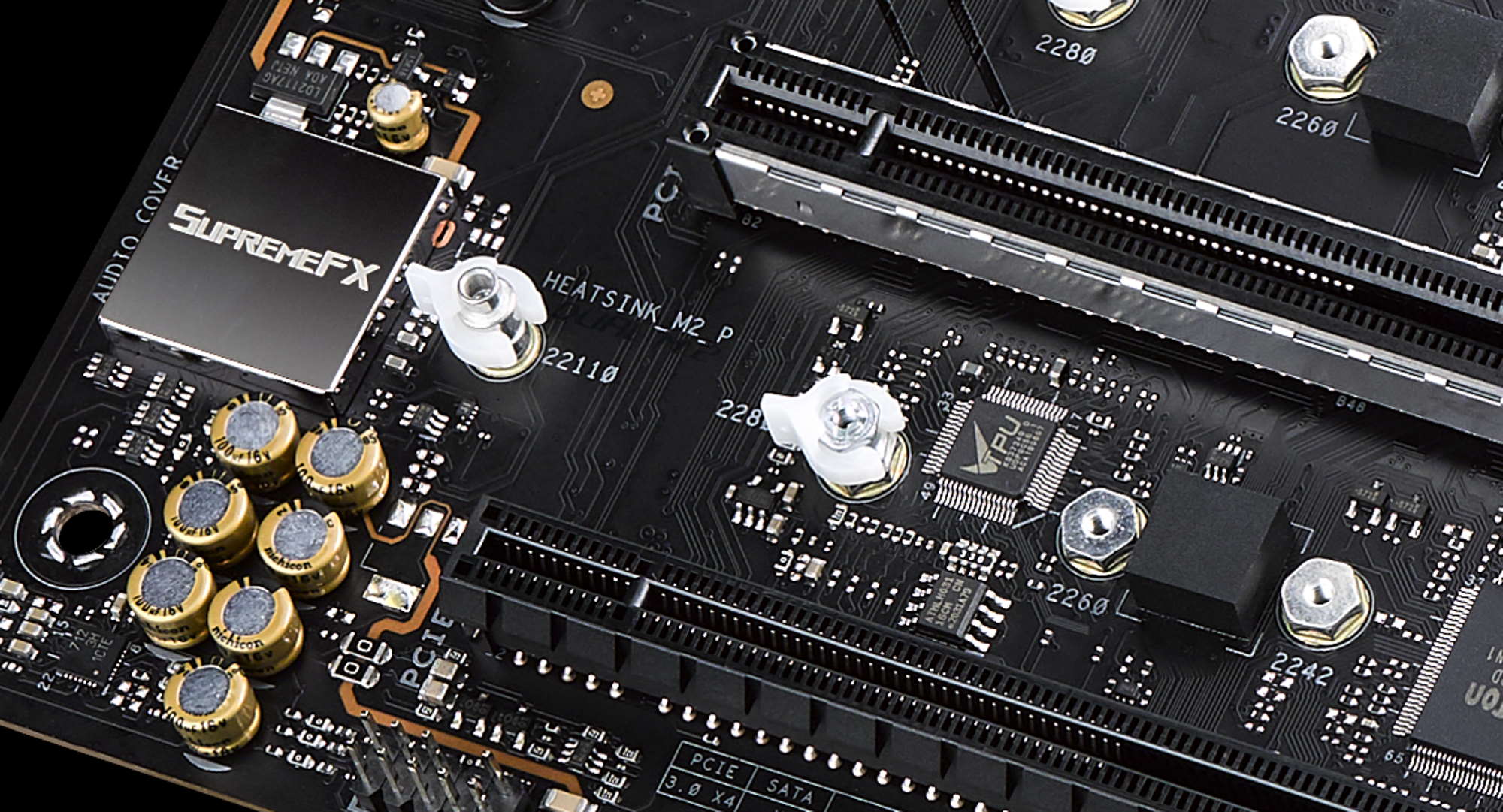
Speaking of software, we’re sweetening the deal for enthusiasts this time around. Select ROG Z590 motherboards now incorporate the widely-used MemTest86 utility right into the firmware interface, making it easier than ever for enthusiasts to check whether their memory overclock is reliable. Instead of preparing a bootable USB drive with MemTest86 and rebooting after a tuning session, enthusiasts and overclockers can streamline their workflow by configuring tuned memory settings and testing them right away. This integration makes for a smoother tuning process and ultimately makes it easier to get the most performance out of your system.
In addition to the integration of MemTest86 in ROG motherboards’ UEFIs, we’re also partnering with FinalWire to bring the popular AIDA64 utility to more enthusiasts. ROG Maximus XIII boards come with a free one-year subscription to AIDA64 Extreme, while ROG Strix buyers will get 60 days of access to the utility. AIDA64 includes a multitude of useful system monitoring and stress-testing tools, as well as an industry-standard suite of benchmarks that you can use to evaluate the performance of your system before and after overclocking.
The Republic of Gamers pulls out all the stops
Back in 2006, a group of our engineers embarked on a mission to create the best motherboards possible, by any means necessary. We wanted to craft products exhibiting the finest workmanship, loaded with the most cutting-edge components, and kitted out with power delivery circuitry fit to push the highest-end CPUs to the very limits of performance. In other words, we set out to build motherboards without compromises. The Republic of Gamers has satisfied the lofty demands of the most hardcore enthusiasts ever since.
Our ROG Maximus XIII series leads the Z590 charge. The ROG Maximus XIII Extreme Glacial is the latest result of our long-running partnership with the liquid-cooling experts at EKWB. It pairs our highest-end PCB design with a full-coverage water block that cools the CPU, VRM, chipset, and more for an unshakeable high-end foundation. The ROG Maximus XIII Extreme uses the same no-holds-barred E-ATX PCB in an air-cooled configuration that’s compatible with a broader range of system builds. And the ROG Maximus XIII Hero brings the quintessential ROG DNA to the broadest range of our most demanding fans.
The Maximus XIII Extreme Glacial is a bespoke foundation for bespoke builds
The ROG Maximus XIII Extreme Glacial stands at the summit of our Z590 motherboard lineup. It’s crammed full of top-shelf hardware and a massive power delivery subsystem that all rests under a bespoke cooling monoblock.
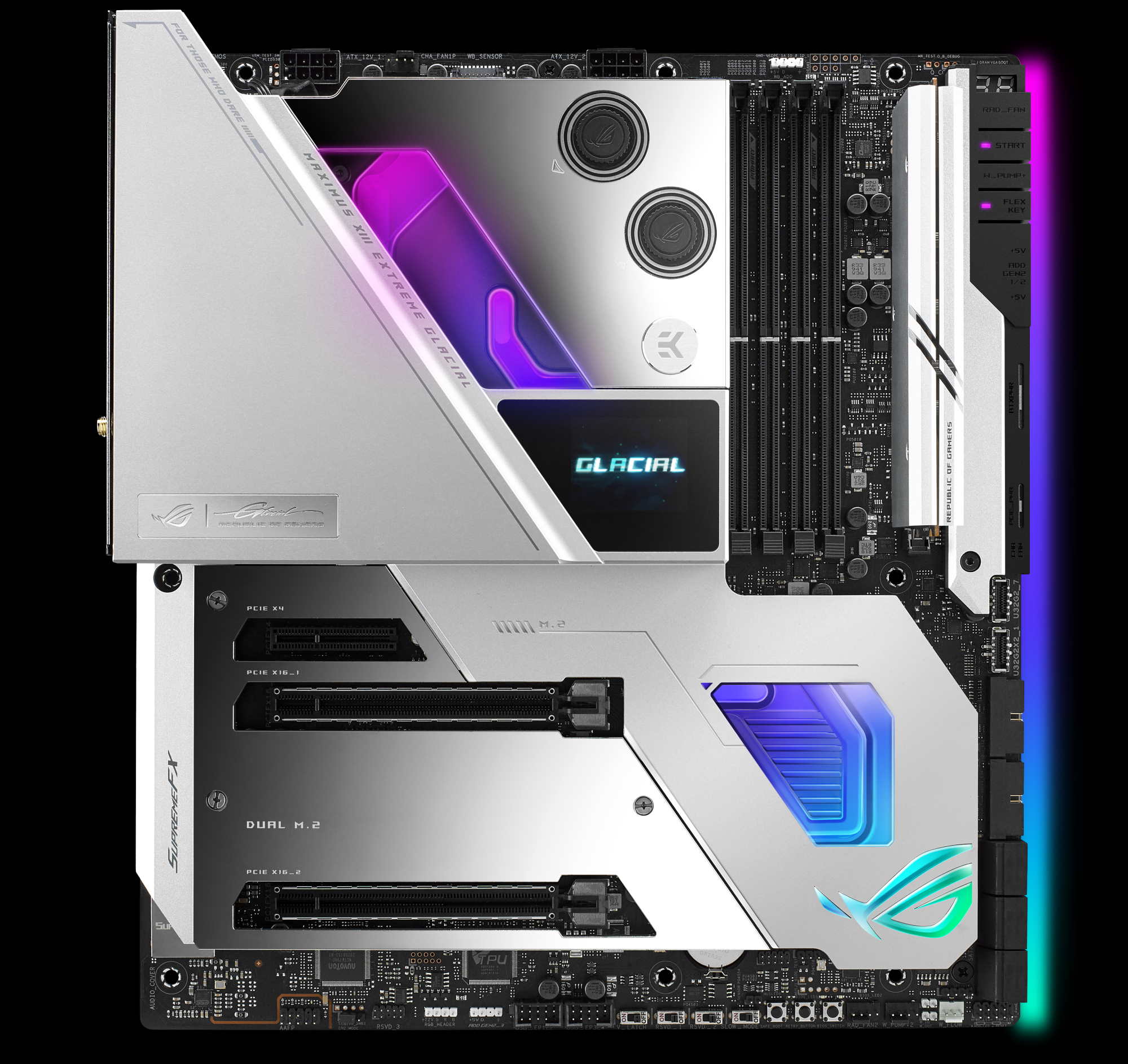
This exquisite Ultrablock, designed in collaboration with the liquid cooling experts at EKWB, covers the CPU, VRM, and chipset to keep those critical components running at their best. In addition to the impressive chill it puts on the CPU, the Ultrablock delivers VRM temperatures up to 37.2°C lower than a common air-cooled configuration. Its primary contact surfaces are made of 99% pure electrolytic copper, and each unit is leak-tested at 15 PSI for rock-solid reliability. A dazzling 1.77” color OLED LiveDash on the Ultrablock displays key system parameters or custom graphics.
To unleash the full performance of overclocked CPUs under the Ultrablock, we lay out an 18+2 teamed power stage topology to power the CPU Vcore and onboard graphics processor. Each power stage is rated for up to 100A of output, and we couple them with MicroFine chokes and 10K black metallic capacitors for the smoothest possible power delivery to the processor, even under the highest loads.
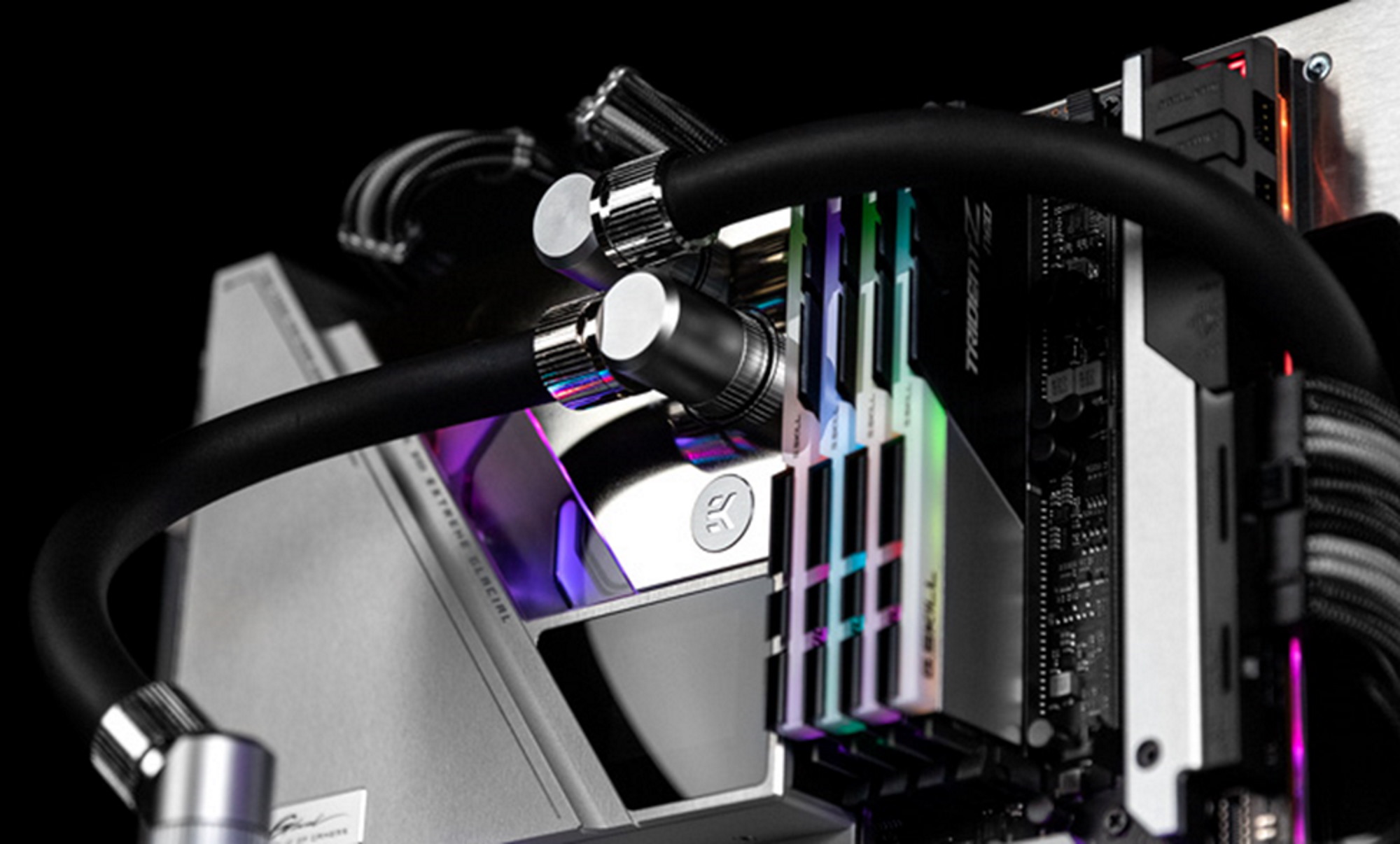
Overclockers will find a comprehensive set of capabilities to let them unleash 11th Gen Core CPUs on the Extreme Glacial. Raw power makes its way into the board via ProCool II EPS connectors. The solid pins in these connectors offer better contact with PSU plugs, improved heat dissipation, and better reliability over common hardware. The four memory slots next to the CPU socket can drive capable DIMMs up to a dizzying 5333MHz thanks to the optimized signaling and layout from our OptiMem III layout. The Q-Code display, eight ProbeIt measurement points, and LN2 mode jumper will come in handy for overclockers probing the limit of 11th Gen CPU performance with exotic coolants and cryo pots.
Liquid cooling setups based around the Extreme Glacial will doubtless include lots of fans, and the board is ready to indulge the vision of the most creative custom builders with a collection of 12 fan headers that can drive 16 fans in total. Six PWM fan headers reside on the board itself, and the included ROG Fan Controller adds another six to the mix. Two of the onboard headers include our exclusive HydraNode technology to run three compatible fans from a single splitter with full control and monitoring over each one. You can keep tabs on every aspect of your cooling loop with a comprehensive collection of liquid flow monitoring headers and sensors, too.
Cooling isn’t the only place where the Extreme Glacial indulges the wildest dreams of bespoke system builders. Custom lighting setups are a key part of any custom-built PC nowadays, and the Extreme Glacial can command a light show worthy of a festival stage. Three Gen 2 addressable RGB headers and a single traditional RGB header on the board itself combine with a whopping six separate Gen 2 addressable headers on the ROG Fan Controller module for a total of ten separate control channels for RGB LED devices. Aura Sync keeps the entire light show running in perfect harmony.
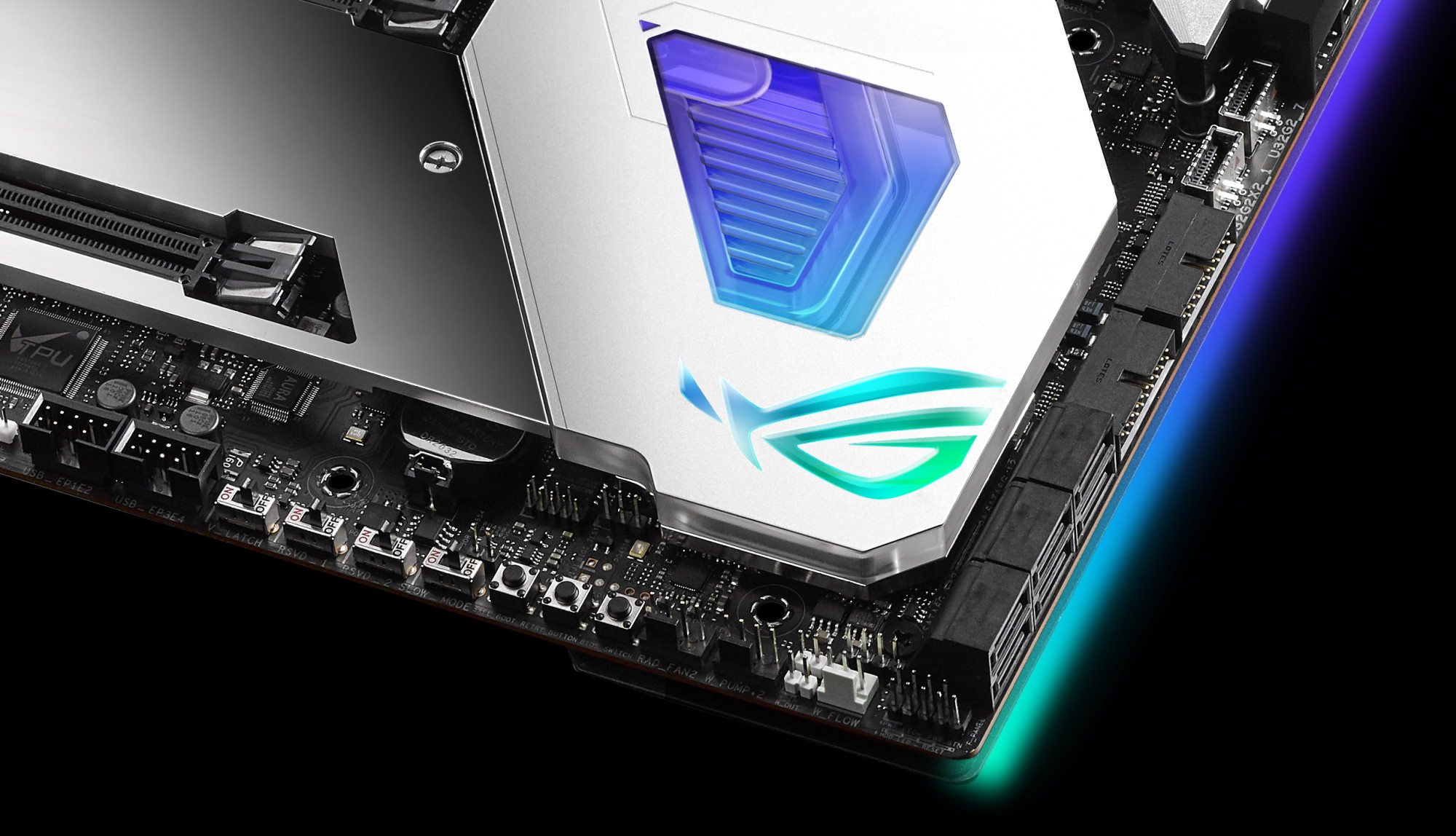
Storage-hungry builders will find five NVMe slots to fill. Three PCIe 4.0 M.2 slots are integrated into the motherboard itself, while the ROG DIMM.2 riser card adds another two PCIe 3.0 mounting points to the party. The main M.2 slots all feature alloy back plates in addition to a monolithic primary storage heatsink to stave off thermal throttling under intense I/O loads. This double-sided cooling design can drop temperatures by up to 10° C compared to traditional M.2 heatsinks. The latest graphics cards can drop into one of the two metal-reinforced PCIe 4.0 x16 SafeSlots, and an additional PCIe 3.0 x4 slot adds extra hardware expansion ability.
The Extreme Glacial’s networking capabilities start with a wired dynamic duo. An Intel-powered 2.5GbE port rests next to a 10GbE connector for the fastest local network transfers. If you’d rather cut the cord, an Intel WiFi 6E adapter lets the efficient and low-latency WiFi 6 protocol stretch its legs over pristine 6GHz spectrum. There’s Bluetooth 5.2 support on tap for the latest wireless peripherals.
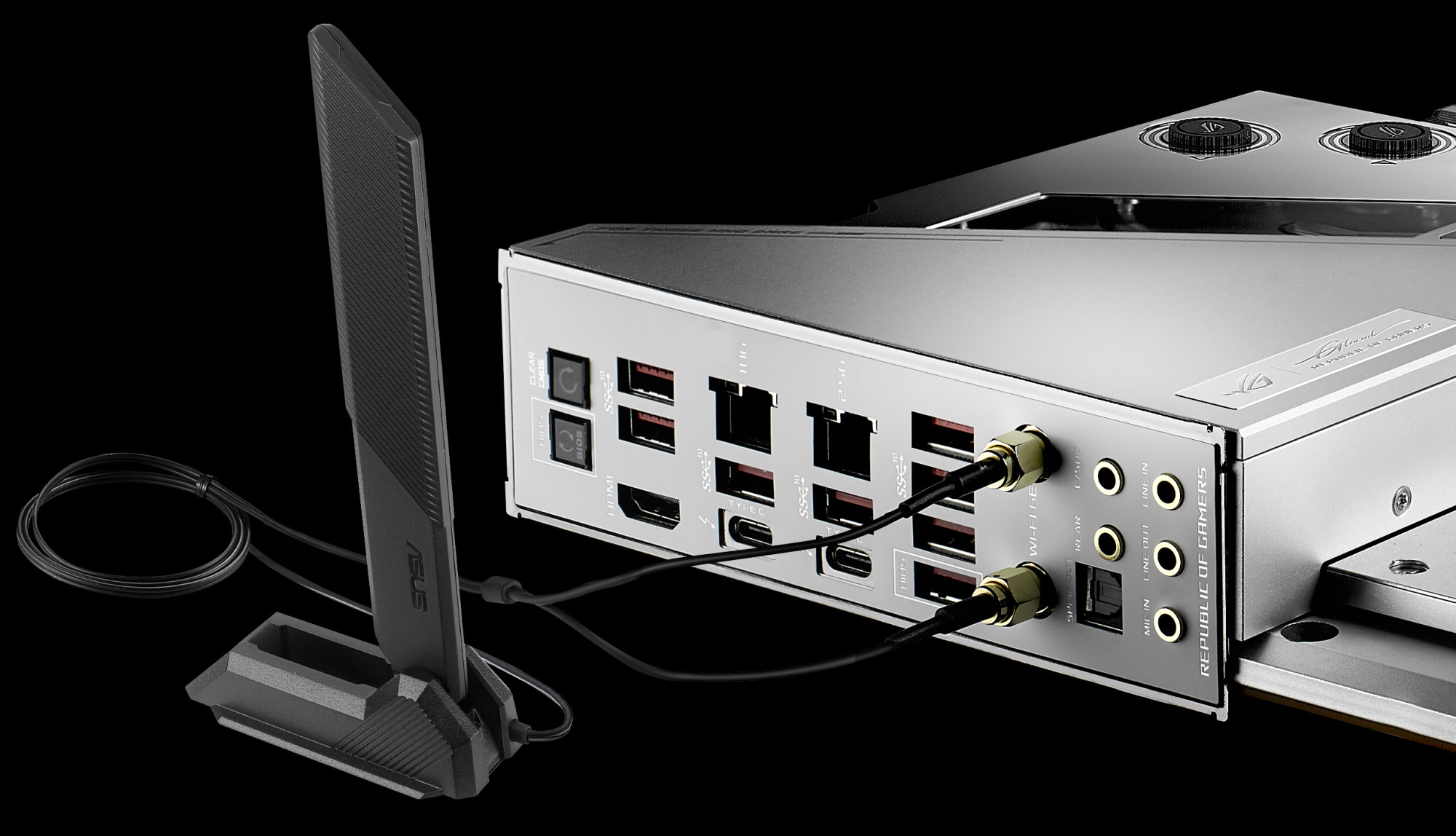
When it comes to peripheral I/O, this board has it all. The stars of the show are two Thunderbolt 4 ports with 40Gbps of bandwidth each that are also capable of pushing 15W to charge a phone or a tablet. Eight more USB 3.2 Gen 2 Type-A ports complete the package. Internal headers let builders wire up a total of 10 more USB connectors, including a USB 3.2 Gen 2×2 port for blazing-fast front panel connectivity.
The next-gen ROG SupremeFX 7.1 ALC4082 audio codec enables a 120dB signal-to-noise ratio for playback and a 113dB SNR for recording, so you’ll both hear and be heard with crystal clarity in games. The front panel output is wired to a dedicated ESS Sabre 9018Q2C DAC for the best experience with audiophile headphones and headsets. For extra convenience, the audio jacks on the panel are all lit up with colored LEDs to make them easy to identify when you’re plugging in a device.
For gamers and audiophiles who want the absolute finest audio output with the most capable headphones, we took a page from our finest gaming headsets to create the ROG Clavis USB-C external DAC. It features not one, but four ESS converters dedicated to discrete ranges of the audible spectrum: lows, mids, highs, and ultra-highs. The Clavis then combines these separate signals into an especially high-fidelity output for an enviable listening experience.

This distinctive DAC can handle 32-bit audio at a 384KHz sampling rate, and it can perform the final “unfold” for Master Quality Authenticated streams to allow for studio-quality playback from services like Tidal. The Clavis’s built-in headphone amplifier can feed demanding cans with impedances up to 300Ω.
The Extreme Glacial’s Sonic Studio software suite includes support for two-way AI Noise Cancelation, cutting down on 95% of background noise from both your microphone and your teammates’ incoming signals. DTS Sound Unbound support lets you enjoy pinpoint-accurate 3D audio.
The Maximus XIII Extreme Glacial includes our full suite of AI features: AI Overclocking for one-click performance boosts, AI Cooling to minimize system noise without any negative impact on operating temperatures, AI Networking for trouble-free traffic prioritization, and the aforementioned two-way AI Noise Cancelation for clear comms.
No matter how extreme your vision for an 11th Gen Core-powered gaming PC may be, the Maximus XIII Extreme Glacial is an ideal starting point.
| ROG Maximus XIII Extreme Glacial | |
|---|---|
| Size | EATX |
| Memory | 4 x DDR4 up to 5333+ (OC) |
| Multi-GPU | 2 x SLI |
| PCIe | 2 PCIe 4.0 x16 @ x16, x8/x8 1 PCIe 3.0 x4 |
| Storage | 3 x M.2 2280 (PCIe 4.0 x4) 1 x M.2 on DIMM.2 (PCIe 3.0 x4 or SATA) 1 x M.2 on DIMM.2 (PCIe 3.0) 6 x SATA 6Gbps |
| Networking | Marvell AQtion AQC113CS 10Gb Ethernet Intel I225-V 2.5Gb Ethernet Intel AX210 WiFi 6E Bluetooth 5.2 |
| Audio | SupremeFX ALC4082 codec ESS Sabre 9018Q2 DAC ROG Clavis USB-C external DAC with ESS Quad-DAC |
| Thunderbolt 4 | 2 x USB-C ports |
| USB | 4: 2 x Type-C 3.2 Gen 2x2: 1 Type-C at front 3.2 Gen 2: 8 x Type-A, 1 x Type-C at front 3.2 Gen 1: 4 x Type-A at front 2.0: 4 x Type-A at front |
| Aura | Onboard: 3 x Gen 2 addressable RGB headers, 1 x standard ROG Fan Controller: 6 x Gen 2 addressable RGB headers |
| Cooling | Onboard: 6 x fan headers ROG Fan Controller: 6 x headers, 2 x sensor 2 x pump, waterblock sensor, water in, water out, flow 2 x HydraNode headers |
The ROG Maximus XIII Extreme is air-cooled perfection
If you fancy the Maximus XIII Extreme Glacial but don’t intend to build a custom liquid-cooling loop, worry not. We have an alternative: the ROG Maximus XIII Extreme.
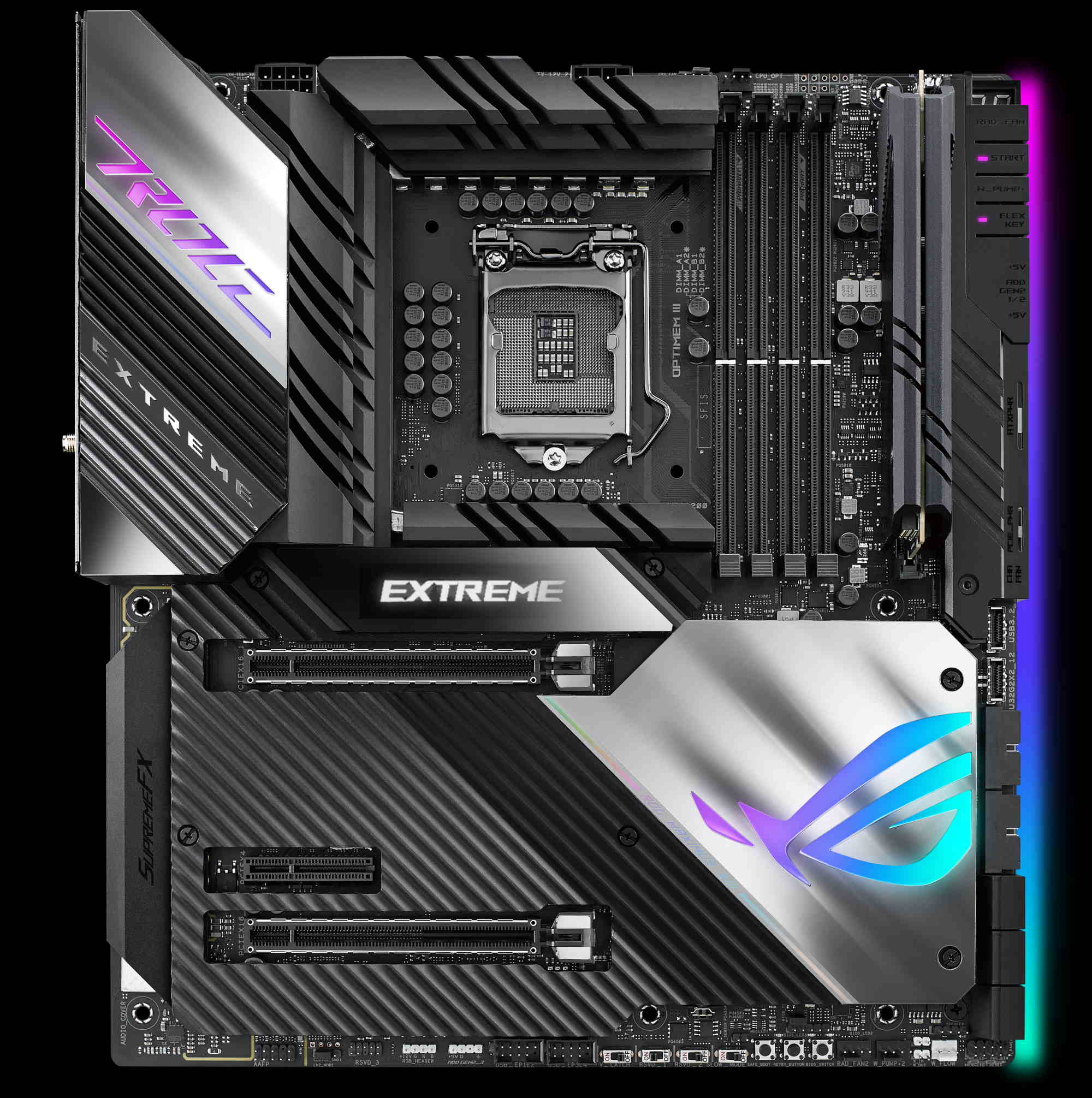
Unlike its fully liquid-cooled sibling, the Maximus XIII Extreme relies on massive high-surface-area heatsinks to keep its VRM, chipset, and M.2 slots chilly. It’s also got a unique style of its own thanks to new ROG typography and iconography spread across the blacked-out I/O shroud and chipset heatsink.
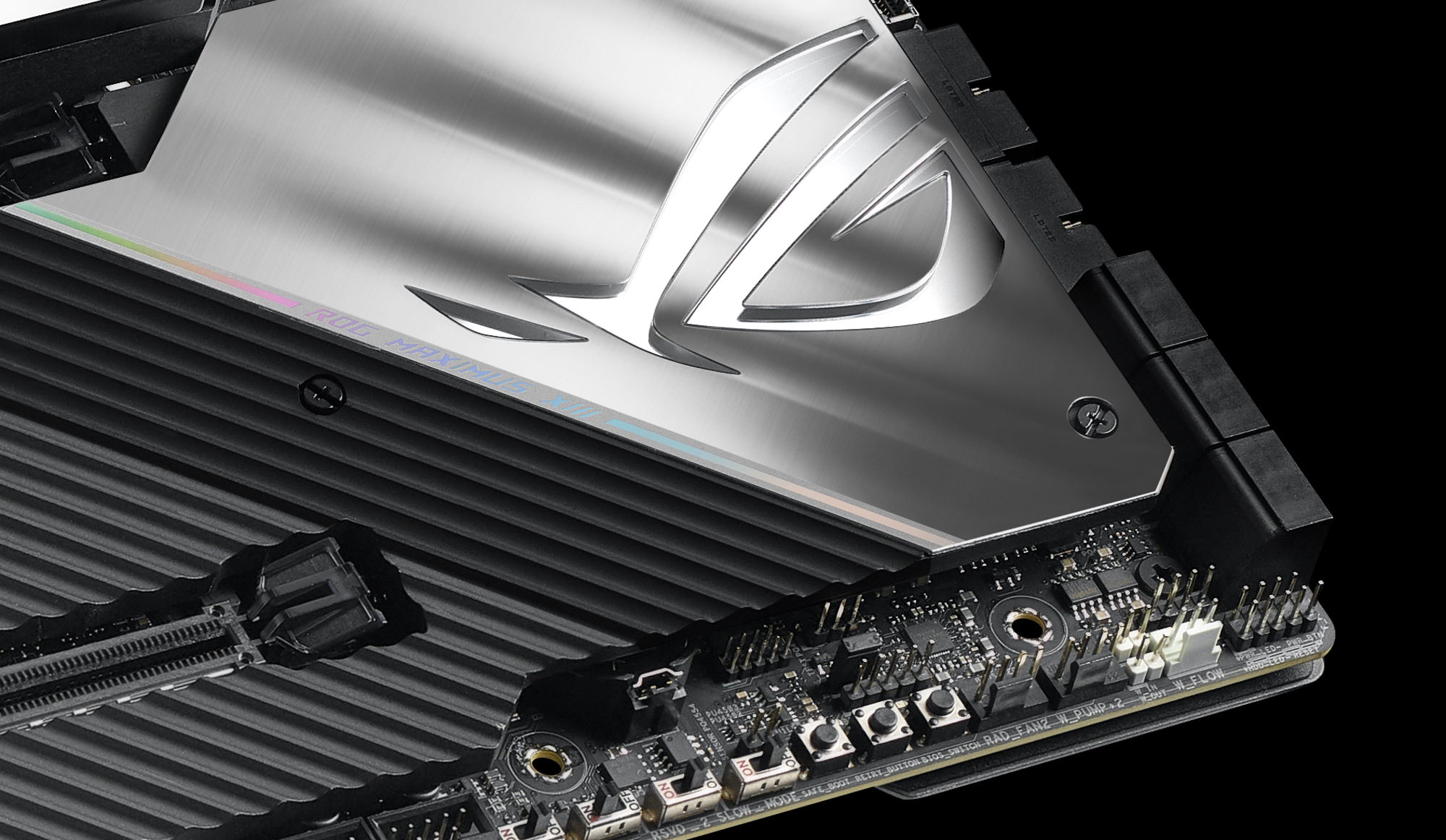
A monochrome LiveDash OLED display mid-board lets you show off custom text and graphics of your choosing, and a 90-degree rotation of the main 24-pin power connector and USB 3.0 front-panel headers ensure clean cable routing for a sharp-looking build. Besides its reliance on air as a cooling medium for its components, the Maximus XIII Extreme includes all the same features and bundled extras as its Glacial stablemate, with an added bonus: the board layout allows you to use two triple-slot graphics cards simultaneously.
| ROG Maximus XIII Extreme | |
|---|---|
| Size | EATX |
| Memory | 4 x DDR4 up to 5333+ (OC) |
| Multi-GPU | 2 x SLI |
| PCIe | 2 PCIe 4.0 x16 @ x16, x8/x8 1 PCIe 3.0 x4 |
| Storage | 3 x M.2 2280 (PCIe 4.0 x4) 1 x M.2 on DIMM.2 (PCIe 3.0 x4 or SATA) 1 x M.2 on DIMM.2 (PCIe 3.0) 6 x SATA 6Gbps |
| Networking | Marvell AQtion AQC113CS 10Gb Ethernet Intel I225-V 2.5Gb Ethernet Intel AX210 WiFi 6E Bluetooth 5.2 |
| Audio | SupremeFX ALC4082 codec ESS Sabre 9018Q2 DAC ROG Clavis USB-C external DAC with ESS Quad-DAC |
| Thunderbolt 4 | 2 x USB-C ports |
| USB | 4: 2 x Type-C 3.2 Gen 2x2: 1 Type-C at front 3.2 Gen 2: 8 x Type-A, 1 x Type-C at front 3.2 Gen 1: 4 x Type-A at front 2.0: 4 x Type-A at front |
| Aura | Onboard: 3 x Gen 2 addressable RGB headers, 1 x standard ROG Fan Controller: 6 x Gen 2 addressable RGB headers |
| Cooling | Onboard: 8 x fan headers ROG Fan Controller: 6 x headers, 2 x sensor 2 x pump, waterblock sensor, water in, water out, flow 2 x HydraNode headers |
The ROG Maximus XIII Hero brings elite specs to ATX
For enthusiasts who want top-level performance in a more mainstream-friendly form factor, we have the ROG Maximus XIII Hero. This board maintains the thoroughly next-generation loadout of its Extreme cousins while trimming down for more typical ATX cases.
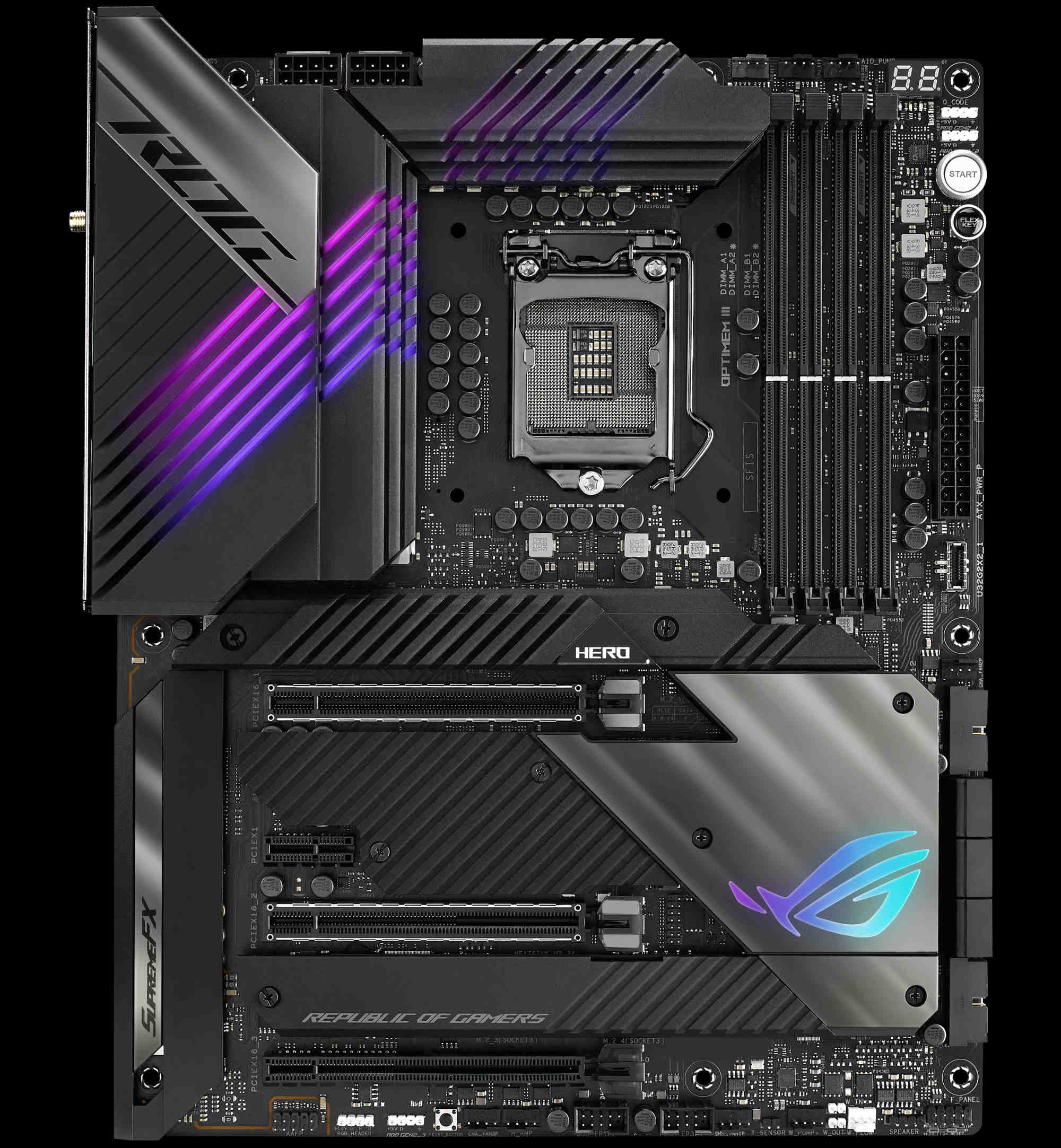
The Maximus XIII Hero boasts a 14+2 VRM topology built with 90A integrated power stages. It’s tailored to the task of overclocking any 11th Gen Core chip you want to drop into the LGA 1200 socket. Thanks to our OptiMem III design approach, DDR4 memory speeds can hit 5333MHz with compatible modules, just like with the Extreme variants.
VRM and chipset cooling comes by way of sizable alloy heatsinks with upgraded thermal pads underneath. The four M.2 slots all have backplates to pull extra heat away from installed SSDs, too. Six fan headers are available, along with two dedicated pump headers and three headers for liquid flow rate, input, and output. Three of the chassis fan headers support our HydraNode tech for individual fan control over three-way splitters.
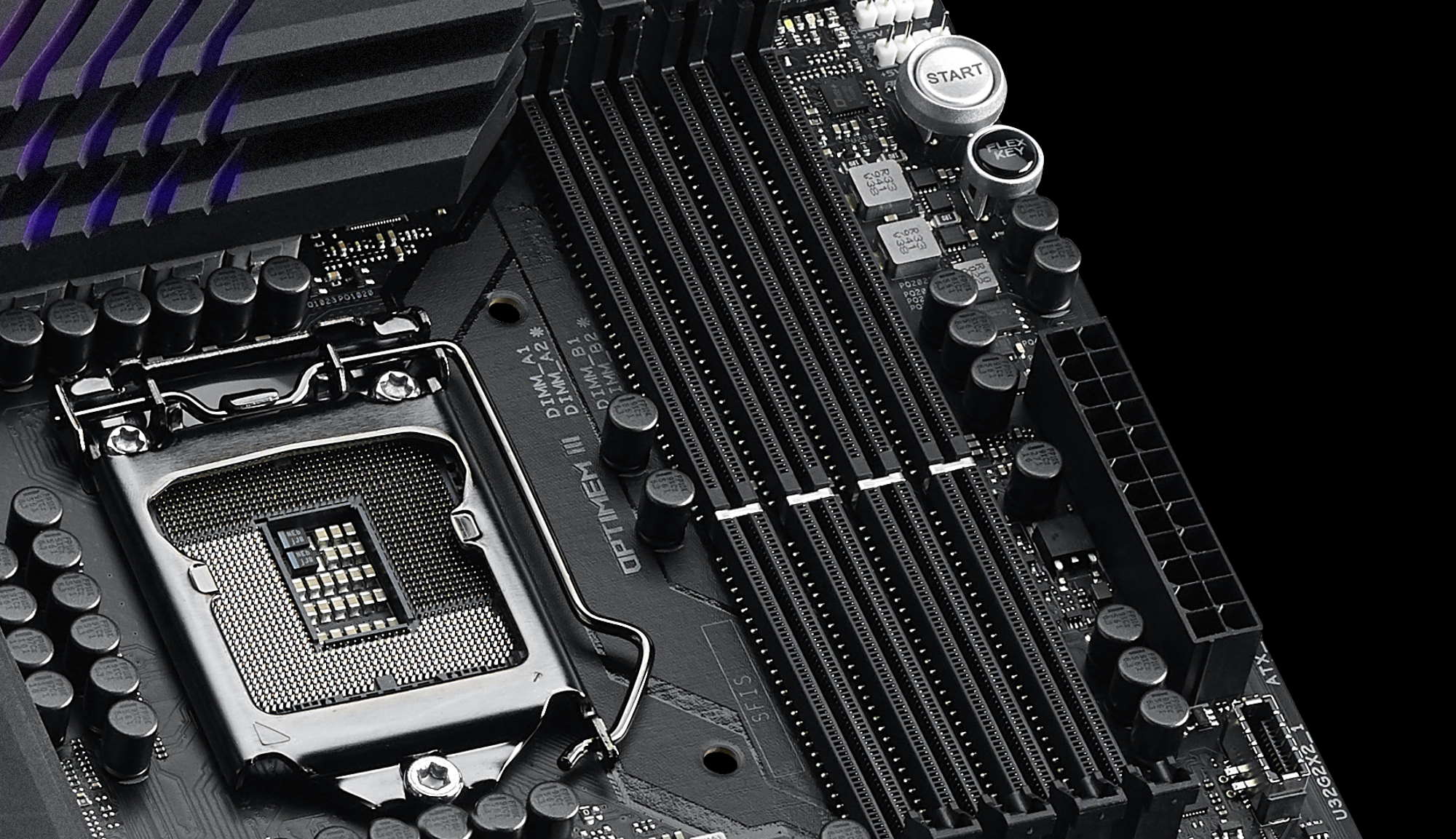
Around the back, you’ll again find two Thunderbolt 4 USB-C connectors, along with six USB 3.2 Gen 2 ports and a pair of USB 2.0 ports. You can hook up a front-panel USB 3.2 Gen 2×2 port for convenient 20Gbps connectivity, along with four USB 3.2 Gen 1 and two USB 2.0 internal headers. Network packets travel to and from the Hero thanks to two Intel 2.5G Ethernet adapters and a mighty Intel WiFi 6E controller that can talk to upcoming routers like our ROG Rapture GT-AXE11000 in the 6GHz band. It also enables Bluetooth 5.2 communication for the latest crop of wireless peripherals.
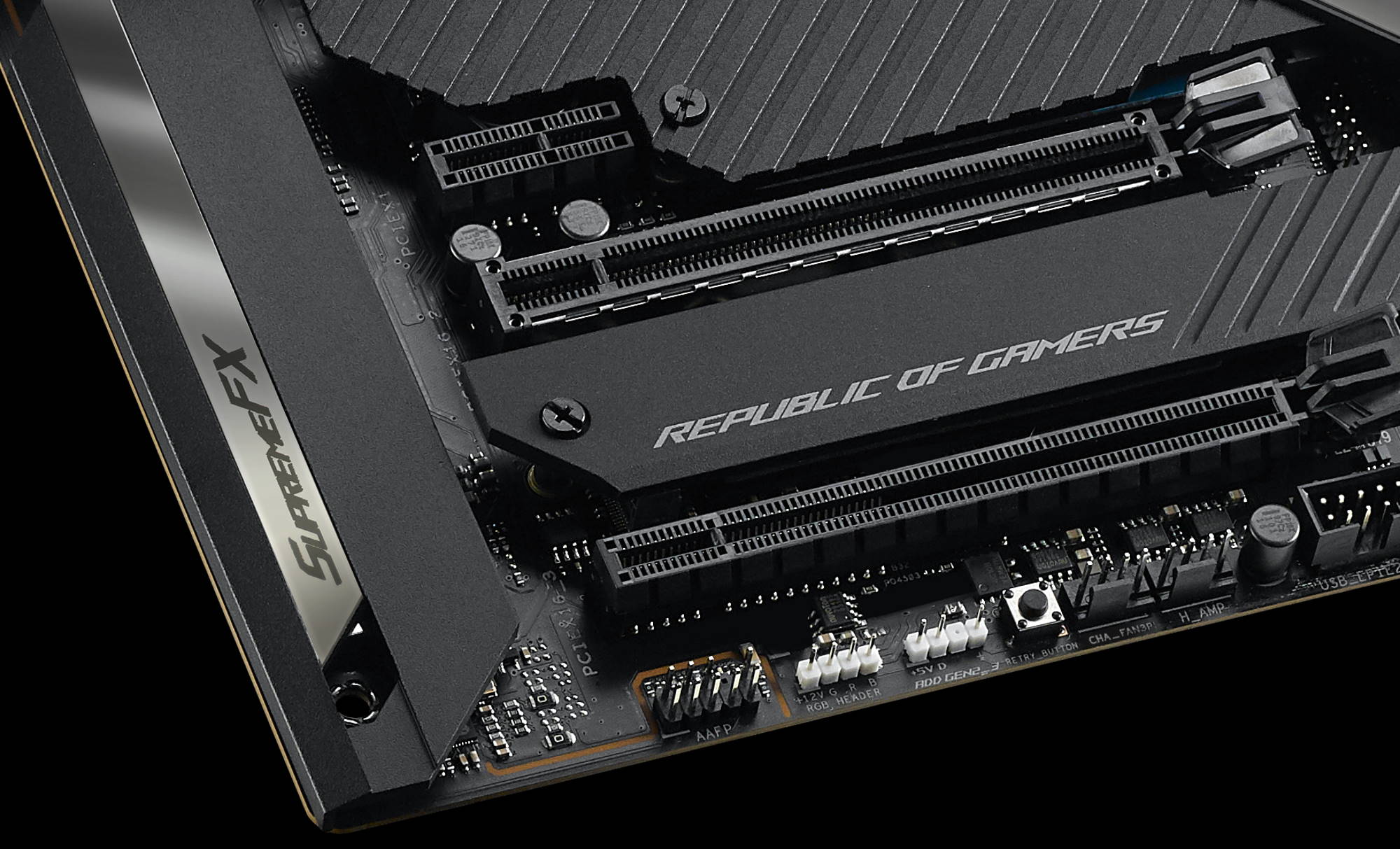
The Maximus XIII Hero is quite a looker all by itself, but it can put on a light show with its built-in LEDs and four RGB headers—three Gen 2 addressable and one standard. The audio configuration is nearly the same as on the Extreme boards. You get an upmarket SupremeFX ALC4082 codec, a refined ESS Sabre 9018Q2C for the front-end connectors, and DTS Sound Unbound support.
Similarly, all of our AI features are available, along with an overclocker-friendly Q-Code LED display and dedicated Start, FlexKey, Reset, and Clear CMOS buttons for easy operation on a test bench.
| ROG Maximus XIII Hero | |
|---|---|
| Size | ATX |
| Memory | 4 x DDR4 up to 5333+ (OC) |
| Multi-GPU | 2 x SLI |
| PCIe | 2 PCIe 4.0 x16 @ x16, x8/x8, x8/x4 1 PCIe 3.0 x16 @ x4 |
| Storage | 1 x M.2 22110 (PCIe 4.0 x4) 1 x M.2 2280 (PCIe 4.0 x4) 1 x M.2 2280 (PCIe 4.0 x3) 1 x M.2 22110 (PCIe 3.0 x4) 6 x SATA 6Gbps |
| Networking | Intel I225-V 2.5Gb Ethernet Intel AX210 WiFi 6E Bluetooth 5.2 |
| Audio | SupremeFX ALC4082 codec ESS Sabre 9018Q2 DAC |
| Thunderbolt 4 | 2 x USB-C ports |
| USB | 4: 2 x Type-C 3.2 Gen 2x2: 1 Type-C at front 3.2 Gen 2: 6 x Type-A 3.2 Gen 1: 4 x Type-A at front 2.0: 2 x Type-A, 4 x Type-A at front |
| Aura | 3 x Gen 2 addressable RGB headers, 1 x standard |
| Cooling | 6 x fan headers 2 x pump, waterblock sensor, water in, water out, flow |
ROG Strix serves up a healthy dose of performance and style
ROG Maximus XIII boards represent the pinnacle of technology and performance for the Z590 generation, and ROG Strix boards distill some of that DNA into more attainable boards that serve up high performance alongside a bold sense of style all their own.
The ROG Strix Z590-E and Z590-F Gaming lead the pack. These two dashing ATX gaming boards blend Aura RGB lighting and cybernetic styling for aggressive looks that match their high performance. The ROG Strix Z590-A caters to builders who want to grab the eye with a white color palette. Small-form-factor system builders will welcome the ROG Strix Z590-I, our take on what a contemporary Mini-ITX board should be. It’s loaded with an unbelievable amount of hardware in a compact form factor.
The ROG Strix Z590-E Gaming WiFi offers glory without excess
The ROG Strix Z590-E Gaming WiFi is aimed squarely at builders who want a sleek, stylish, and feature-packed ATX mobo that doesn’t go overboard. A 14+2 stage VRM borders the CPU socket, and we keep it cool with a massive heatsink array that’s integrated with the metal I/O shroud for swift heat dissipation even under heavy CPU loads.
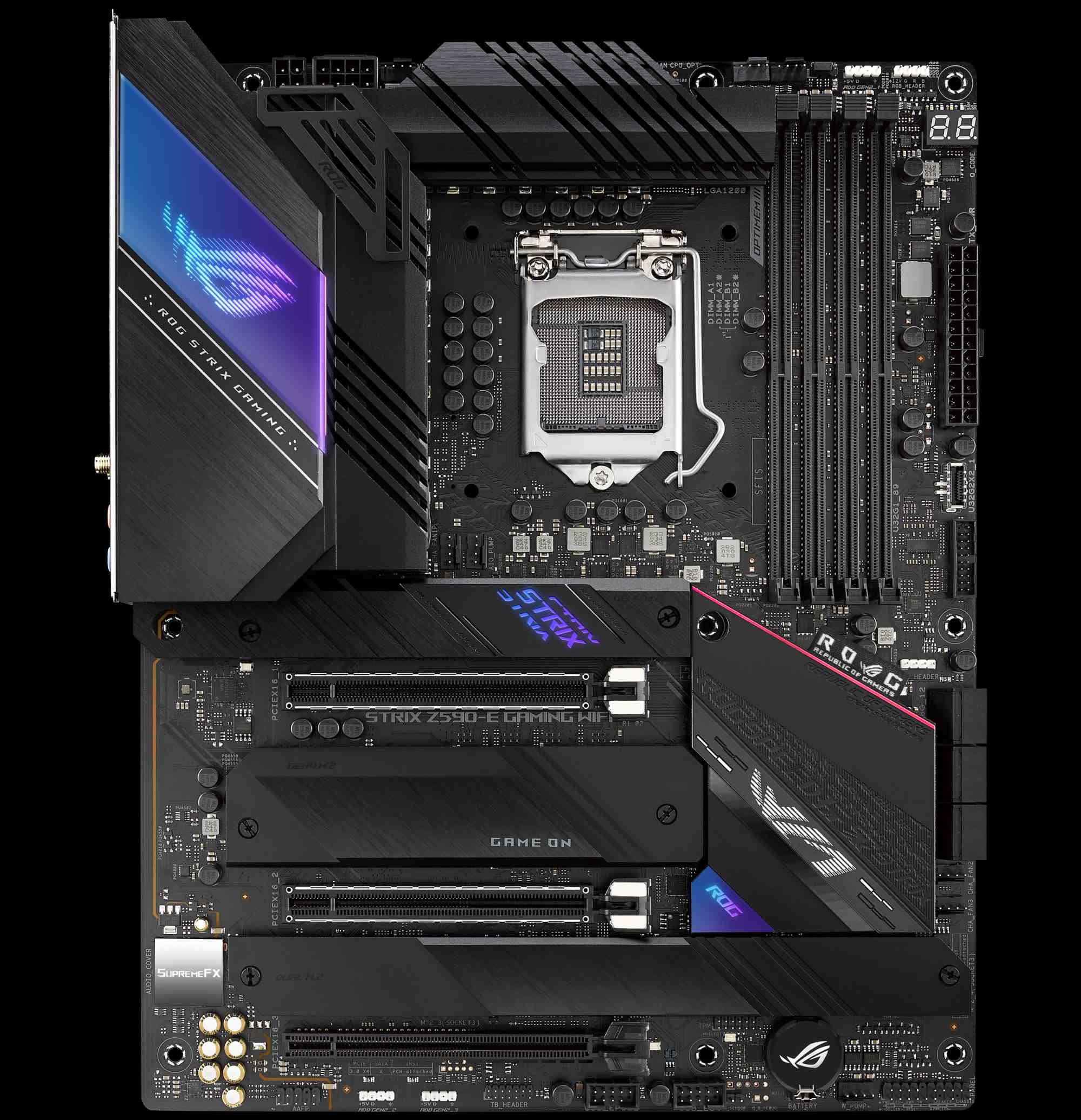
Each EPS auxiliary power connector uses ProCool II connectors with solid pins for stable, reliable power delivery, and the DIMM slots push worthy sticks to 5333MHz and beyond thanks to our OptiMem III design. Six fan headers handle air cooling needs, while dedicated AIO and pump headers wrangle both pre-built and custom liquid-cooling solutions. One of those fan headers supports our HydraNode tech, providing individual control and monitoring for up to three compatible fans off a single splitter.
Three PCIe x16 slots (two 4.0, one 3.0) are primed to accept multiple GPUs or expansion cards with ease. Four M.2 slots offer storage-hungry builders a wide range of configuration options. All of these M.2 slots rest under heatsinks for high sustained performance, and we cool the main PCIe 4.0 M.2 SSD slot with both front- and back-side heatsinks. Our clever engineers found a great way to stop all that annoying fiddling about with tiny M.2 screws on these drive slots, too. The new Q-Latch system lets you secure an SSD with just a turn of a plastic tab—no tools required.
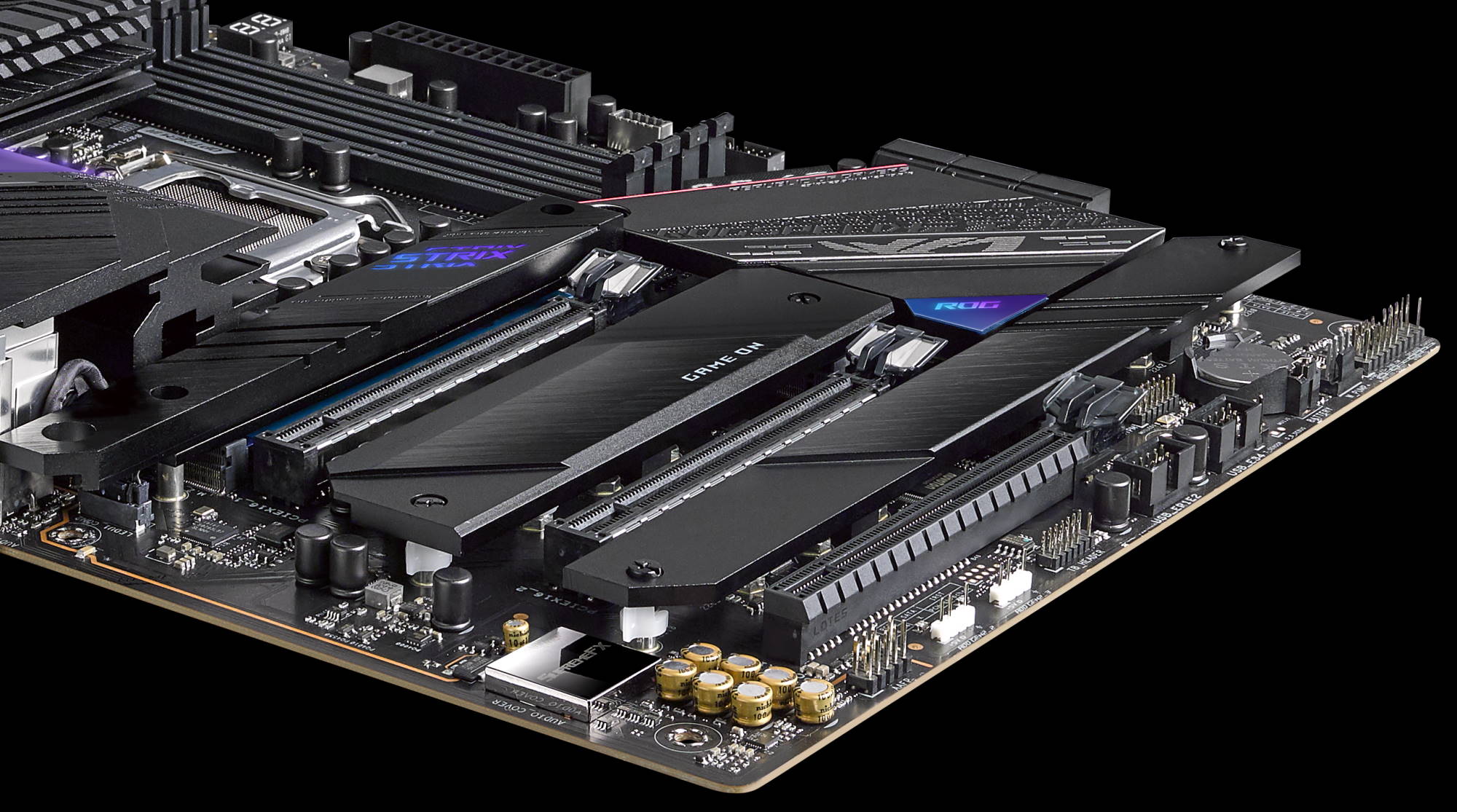
This board has a sense of style all its own. A futuristic cybernetic motif and three RGB LED zones subtly project your ROG allegiance. Additional strips and case lighting can use the three Gen 2 addressable RGB headers and one standard RGB connector. All the hues and effects can be configured with our Aura utility via Armoury Crate.
Peripheral connectivity options abound in the I/O panel. Networking is taken care of by a tag team of two Intel 2.5G Ethernet controllers, and you can opt to go wireless with an all-new Intel WiFi 6E adapter with 6GHz frequency support. USB connectivity includes two Type-C connectors, one USB 3.2 Gen 2×2 and the other USB 3.2 Gen 2, along with a selection of six USB 3.2 Gen 1 and USB 2.0 Type-A ports. You can tap another seven ports through internal headers, including a USB 3.2 Gen 2 2×2 connector for speedy front-panel transfers. There’s also a Thunderbolt 4 header for future expansion.
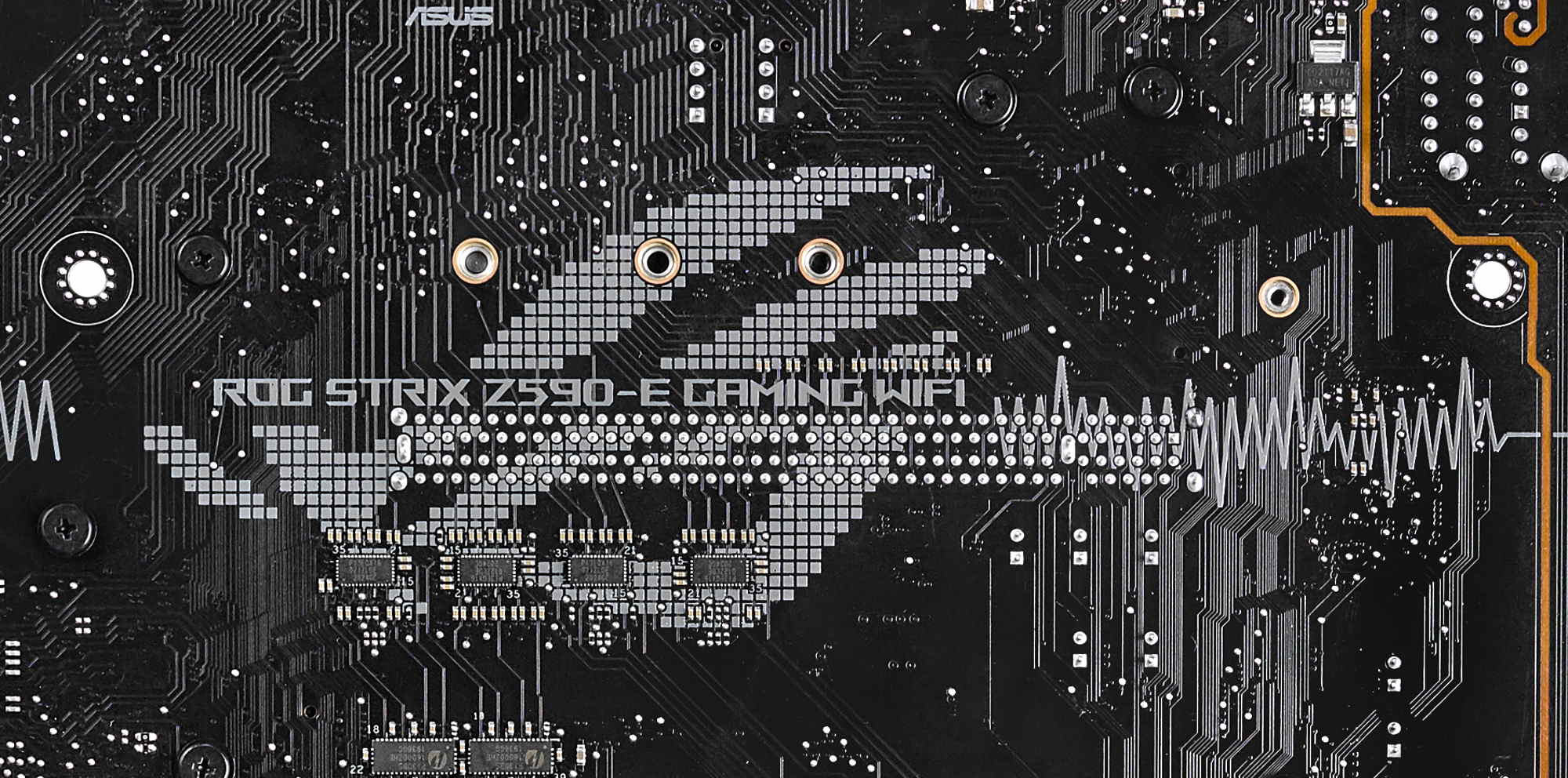
For the Z590 generation, we upped the audio game in ROG Strix boards, and the ROG Strix Z590-E Gaming serves up the full arsenal of improvements. A SupremeFX ALC4080 codec pipes crystal-clear audio to the rear ports, and front-panel headphone users will enjoy the output of a dedicated Savitech SV3H712 headphone amplifier. There’s also support for Two-way AI Noise Cancelation, DTS Sound Unbound 3D audio, and our range of audio enhancements, including Sonic Studio III, Sonic Studio Virtual Mixer, and Sonic Radar III.
The ROG Strix Z590-E Gaming enjoys many of the enthusiast-friendly features of the ROG Maximus XIII series. Builders will find a Q-Code LED display, Q-LED boot status lights, FlexKey remappable utility button, onboard CMOS clear button, and, of course, BIOS FlashBack support. Full support for our suite of AI technologies make it easy to get the most out of your system.
| ROG Strix Z590-E Gaming WiFi | |
|---|---|
| Size | ATX |
| Memory | 4 x DDR4 up to 5333+ (OC) |
| Multi-GPU | 2 x SLI |
| PCIe | 2 PCIe 4.0 x16 @ x16, x8/x8, x8/x4 1 PCIe 3.0 x16 @ x4 |
| Storage | 2 x M.2 22110 (PCIe 4.0 x4) 1 x M.2 22110 (PCIe 3.0 x4) 1 x M.2 2280 (PCIe 3.0 x4 or SATA) 6 x SATA 6Gbps |
| Networking | 2x Intel I225-V 2.5Gb Ethernet Intel AX210 WiFi 6E Bluetooth 5.2 |
| Audio | SupremeFX ALC4080 codec Savitech SV3H712 headphone amp |
| Thunderbolt 4 | Internal header |
| USB | 4: Internal header 3.2 Gen 2x2: 1 x Type-C, 1 x Type-C at front 3.2 Gen 2: 1 x Type-C, 2 x Type-A 3.2 Gen 1: 2 x Type-A, 4 x Type-A at front 2.0: 2 x Type-A, 4 x Type-A at front |
| Aura | 3 x Gen 2 addressable RGB headers, 1 x standard |
| Cooling | 7 x fan headers 2 x pump |
The ROG Strix Z590-F Gaming WiFi shows a different side of Strix
For a different take on the formula of the ROG Strix Z590-E Gaming WiFi with a near-identical feature set and a slightly smaller price tag, we offer the ROG Strix Z590-F. This model rolls with a style all its own and some sensible subtractions from the spec sheet, but it’s otherwise a dead ringer for its beefier brother.
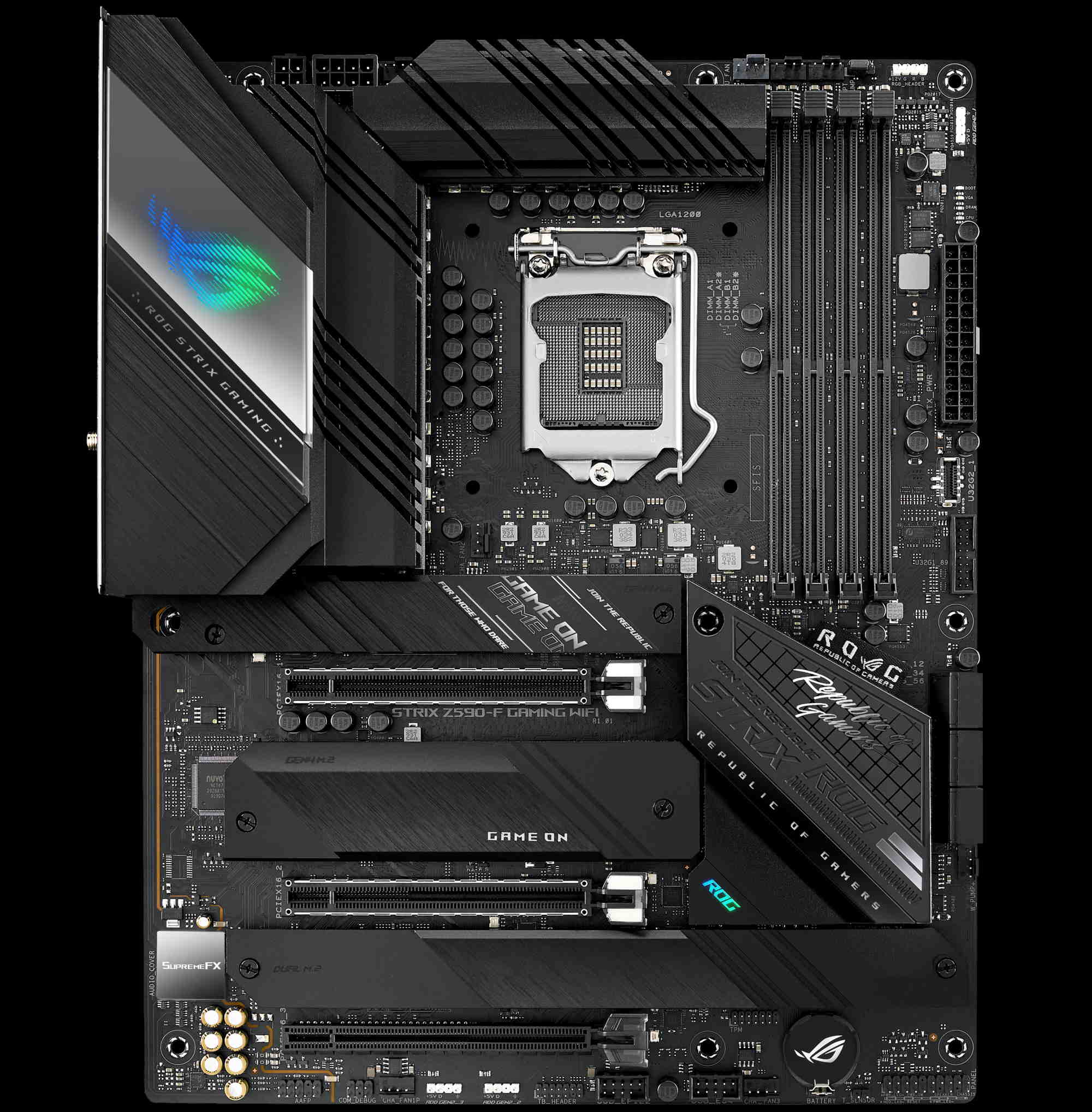
The 14+2 stage VRM and quartet of M.2 slots all reprise their role, as does the enhanced audio section with its SupremeFX ALC4080 chip and Savitech headphone amp. The Q-Code LED bids farewell, but handy features like POST status LEDs, FlashBack support, and FlexKey all remain. The ROG Strix Z590-F Gaming WiFi maintains lofty memory overclocking capabilities with our OptiMem II design approach.
Likewise, the connectivity options are altogether similar. The Intel WiFi 6E adapter sticks around, although there’s only one Intel 2.5G Ethernet port. The front-panel USB 3.2 Gen 2×2 header goes away, but a rear-panel Type-C port still offers that high-speed connectivity. If you prefer the ROG Strix Z490-F Gaming’s style (and more attainable price point) over its Strix-E sibling, you don’t have to give up much in the way of substance to enjoy it.
| ROG Strix Z590-F Gaming WiFi | |
|---|---|
| Size | ATX |
| Memory | 4 x DDR4 up to 5333+ (OC) |
| Multi-GPU | n/a |
| PCIe | 2 PCIe 4.0 x16 @ x16, x8/x4 1 PCIe 3.0 x16 @ x4 |
| Storage | 2 x M.2 22110 (PCIe 4.0 x4) 1 x M.2 22110 (PCIe 3.0 x4) 1 x M.2 2280 (PCIe 3.0 x4 or SATA) 6 x SATA 6Gbps |
| Networking | Intel I225-V 2.5Gb Ethernet Intel WiFi 6E Bluetooth 5.2 |
| Audio | SupremeFX ALC4080 codec Savitech SV3H712 headphone amp |
| Thunderbolt 4 | Internal header |
| USB | 4: Internal header 3.2 Gen 2x2: 1 x Type-C 3.2 Gen 2: 1 x Type-C, 2 x Type-A, 1 x Type-C at front 3.2 Gen 1: 2 x Type-A, 4 x Type-A at front 2.0: 2 x Type-A, 4 x Type-A at front |
| Aura | 3 x Gen 2 addressable RGB headers, 1 x standard |
| Cooling | 7 x fan headers 2 x pump |
The ROG Strix Z590-A Gaming WiFi inverts the color scheme for a unique look
White is back in fashion in the PC-building world, and for good reason. It’s clean, fresh, and looks particularly good under RGB lighting. The ROG Strix Z590-A is the clear choice for builders seeking to switch up the usual black color palette of modern motherboards.
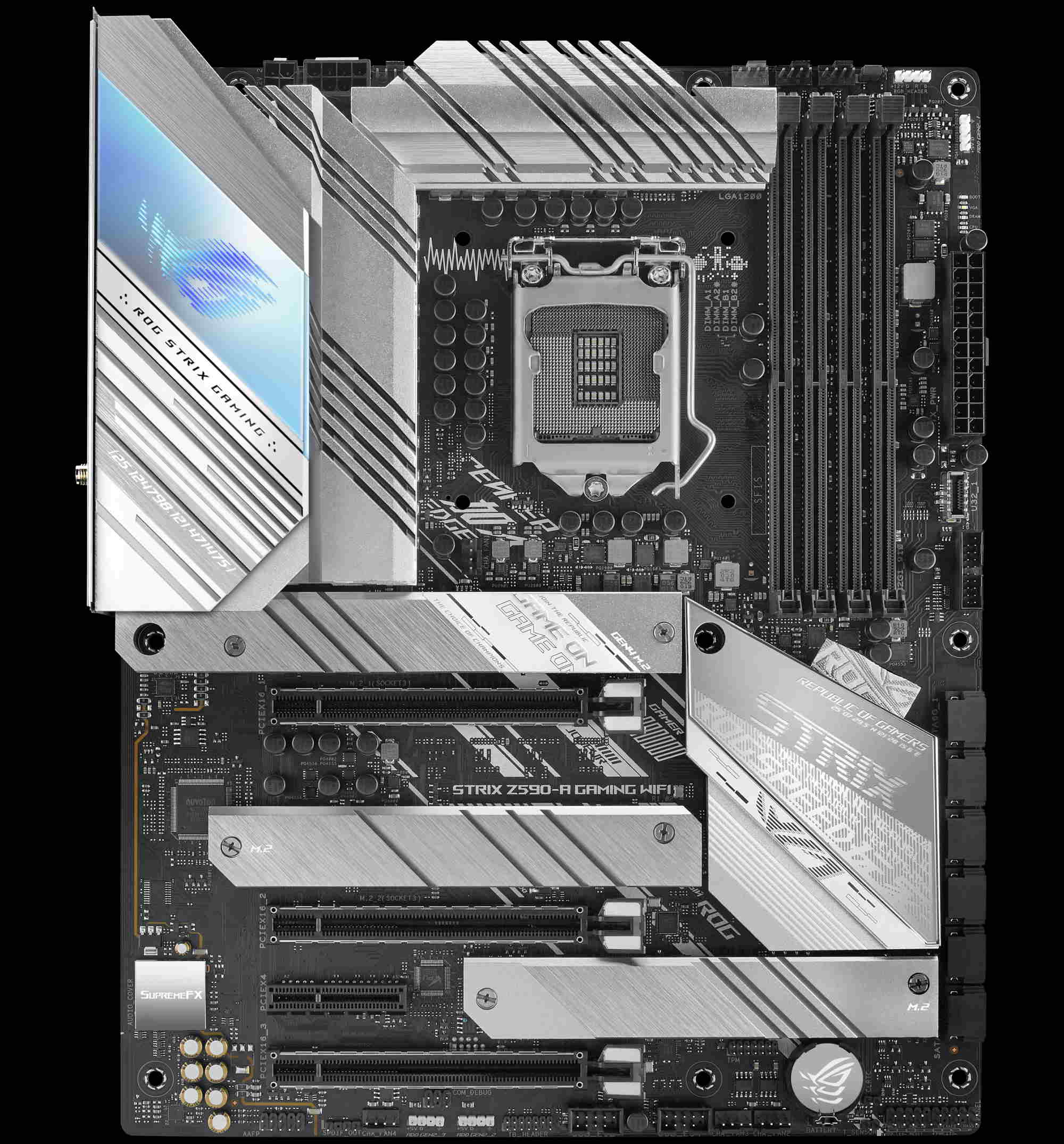
Spec-wise, the Z590-A Gaming WiFi hews fairly closely to the upper models in the range. We trim back the PCIe slot selection to a trio of physical x16 slots rounded out by a fourth x4 connector, and the number of M.2 devices tops out at three. The main Ethernet port is driven by an Intel 2.5G controller, but the Intel WiFi 6 radio sticks to the proven 2.4GHz and 5GHz bands.
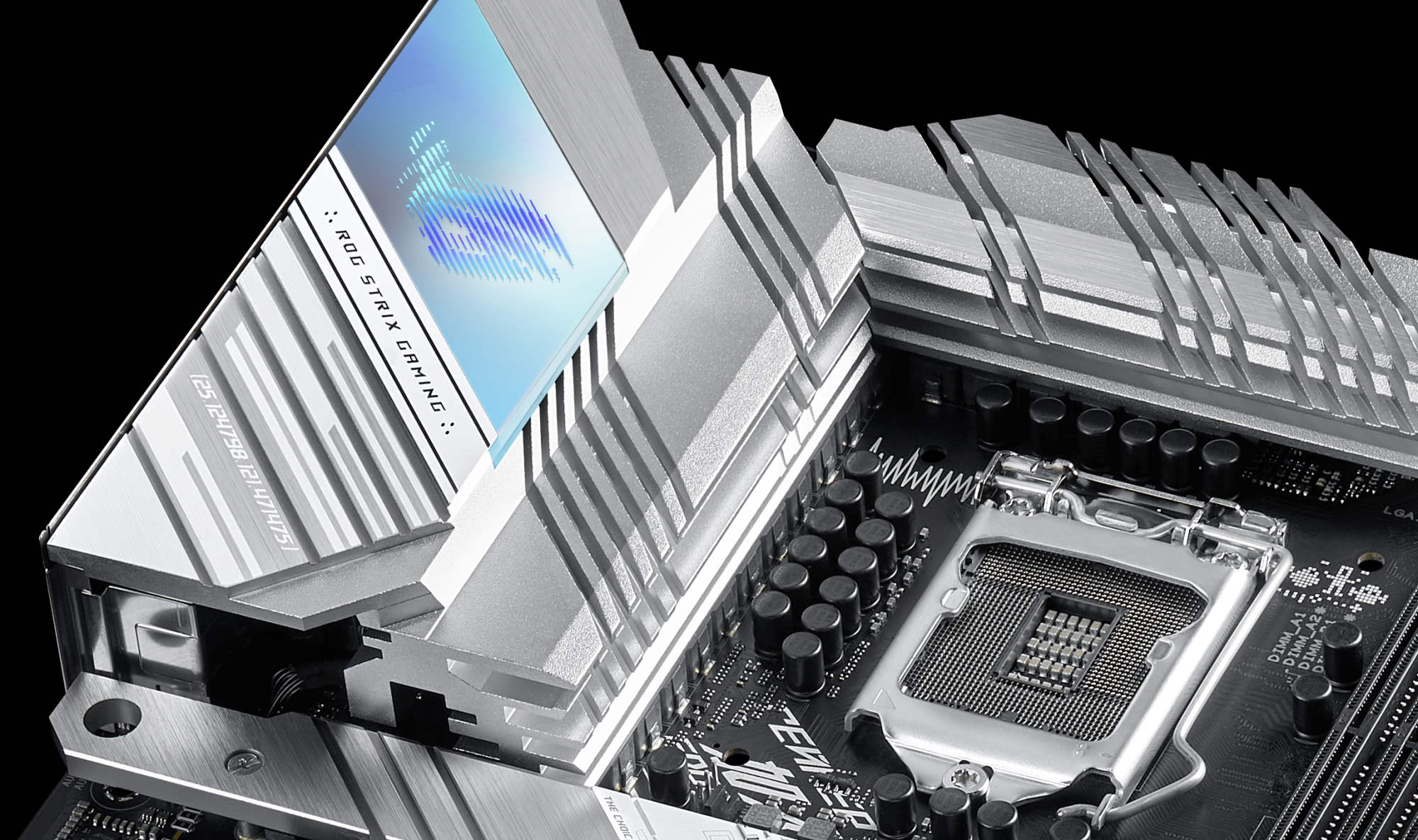
The USB port collection is lightly trimmed back from our fancier boards, but it still includes a USB 3.2 Gen 2×2 20Gbps Type-C port for high-speed peripherals. The onboard Clear CMOS button goes away, but many builder-friendly features like FlexKey, Q-LED, and the ever-so-handy M.2 Q-Latches remain. The audio setup and functionality are identical to those of the Strix Z590-E and Z590-F.
| ROG Strix Z590-A Gaming WiFi | |
|---|---|
| Size | ATX |
| Memory | 4 x DDR4 up to 5333+ (OC) |
| Multi-GPU | n/a |
| PCIe | 3 PCIe 4.0 x16 @ x16, x8/x4/x4 1 PCIe 3.0 x4 |
| Storage | 1 x M.2 22110 (PCIe 4.0 x4) 2 x M.2 22110 (PCIe 3.0 x4 or SATA) 6 x SATA 6Gbps |
| Networking | Intel I225-V 2.5Gb Ethernet Intel WiFi 6 Bluetooth 5.1 |
| Audio | SupremeFX ALC4080 codec Savitech SV3H712 headphone amp |
| Thunderbolt 4 | Internal header |
| USB | 4: Internal header 3.2 Gen 2x2: 1 x Type-C 3.2 Gen 2: 4 x Type-A 3.2 Gen 1: 1 x Type-C at front, 2 x Type-A at front 2.0: 4 x Type-A, 1 Type-C audio, 4 x Type-A at front |
| Aura | 3 x Gen 2 addressable RGB headers, 1 x standard |
| Cooling | 7 x fan headers 1 x pump |
The ROG Strix Z590-I Gaming WiFi puts a world of possibilities in the palm of your hand
Here’s a tough question: how do you put most of the features of an ROG motherboard in a space that’s only 6.7 by 6.7 inches square? It’s a tough nut to crack, yet it’s exactly what the ROG Strix Z590-I Gaming WiFi does. This board is perfect for building a compact high-end PC, whether your goal is a space-saving desktop system, an HTPC, or a console replacement.
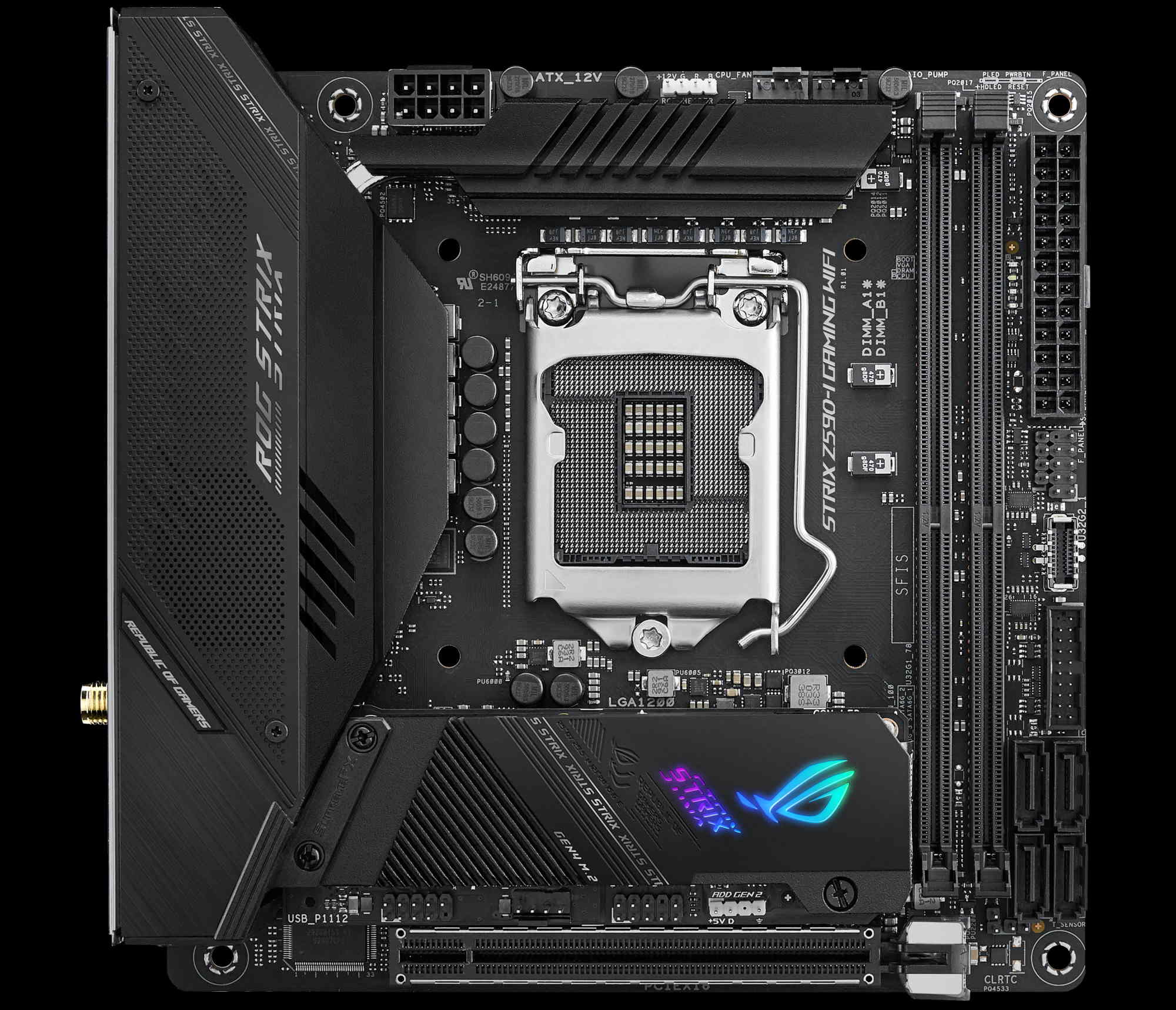
The Z590-I’s PCB hosts an 8+2 stage VRM with 90A power stages for capable power delivery even with the highest-end 11th Gen CPUs. A large two-part heatsink covers the power-delivery circuitry, and heatpipes underneath border the CPU socket and run into the I/O shield. Active VRM cooling ensures that each component stays chilly, even during all-out operation inside small enclosures.
The PCB itself is built with 10 layers, helping with heat dissipation and overclocking headroom. Like its bigger brothers, this board can drive compatible DIMMs to 5333MHz and perhaps even beyond.
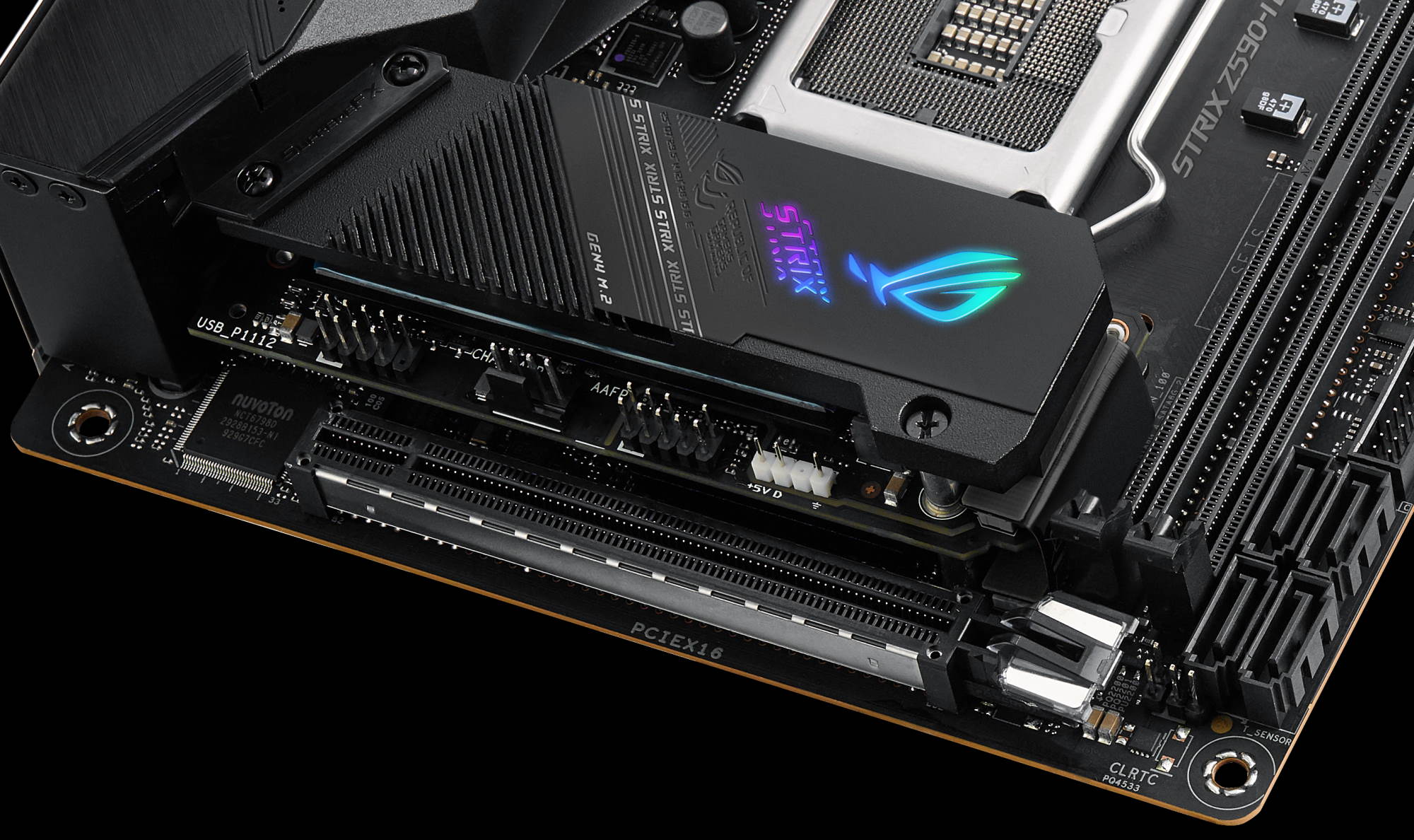
Compact though it may be, the Strix Z590-I still has room for two M.2 slots (one of them with a backplate for better cooling), and both an Intel 2.5G Ethernet controller and a 6GHz WiFi 6E adapter with Bluetooth 5.2 support. The port selection wouldn’t look out of place in a much bigger board, either. There’s a Thunderbolt 4 USB-C port alongside six more USB ports, including a USB 3.2 Gen 2×2 connector. If those USB options aren’t enough, there are internal headers for four more such ports, including a USB 3.2 Gen 2 Type-C port.
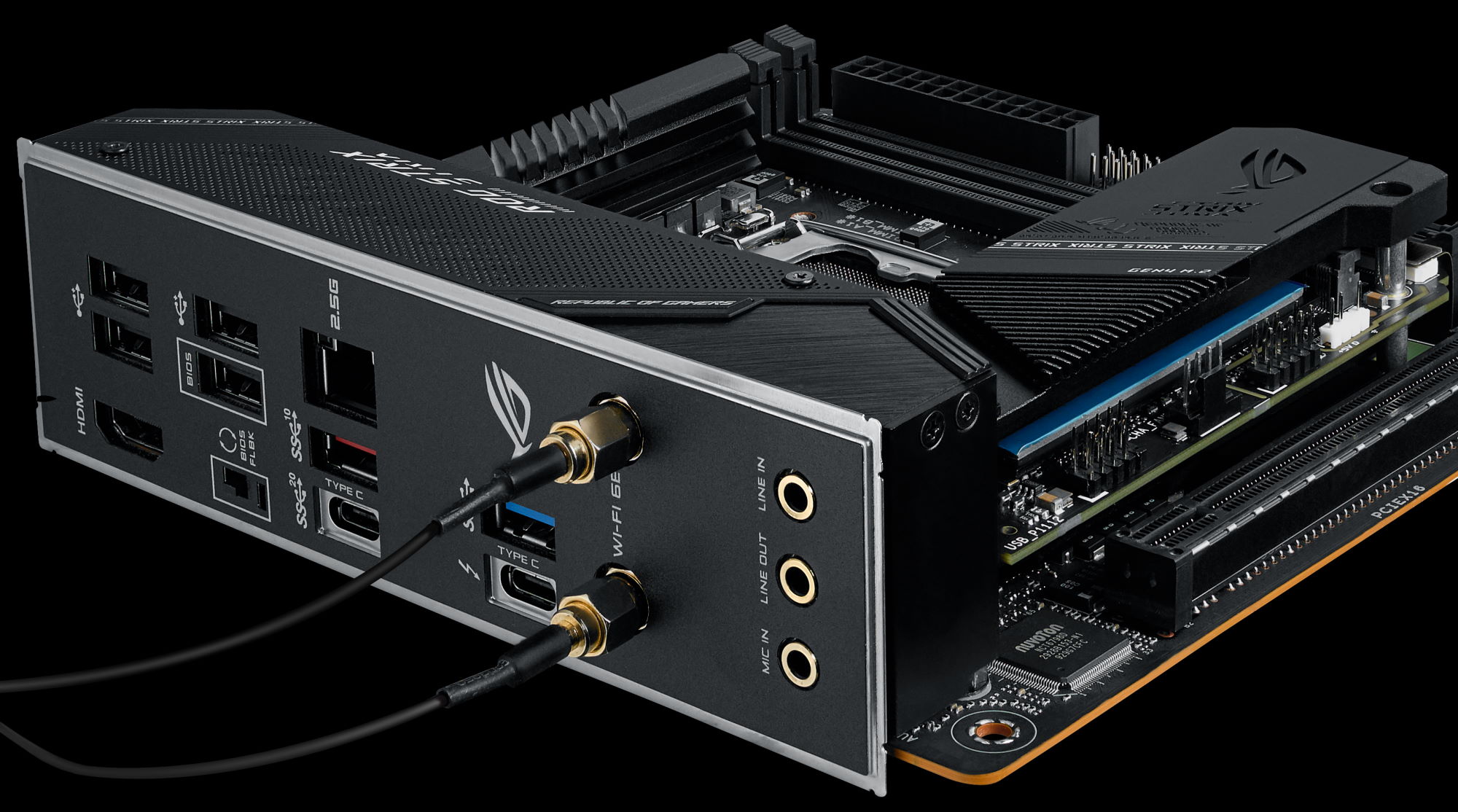
There’s a dash of RGB LEDs front and center on the Z590-I Gaming, plus two additional headers for RGB strips. One supports Gen 2 addressable devices, and the other supports four-pin lighting. The audio jacks have LEDs built in for easy identification in dark entertainment centers. A SupremeFX ALC4080 codec with a Savitech headphone amp takes care of audio duties. Two-way AI Noise Cancelation and our full suite of AI tech round out this pint-size powerhouse.
| ROG Strix Z590-I Gaming WiFi | |
|---|---|
| Size | Mini ITX |
| Memory | 2 x DDR4 up to 5133+ (OC) |
| Multi-GPU | n/a |
| PCIe | 1 PCIe 4.0 x16 @ x16 |
| Storage | 1 x M.2 22110 (PCIe 4.0 x4) 2 x M.2 22110 (PCIe 3.0 x4 or SATA) 6 x SATA 6Gbps |
| Networking | Intel I225-V 2.5Gb Ethernet Intel WiFi 6 Bluetooth 5.1 |
| Audio | SupremeFX ALC4080 codec Savitech SV3H712 headphone amp |
| Thunderbolt 4 | Internal header |
| USB | 4: Internal header 3.2 Gen 2x2: 1 x Type-C 3.2 Gen 2: 4 x Type-A 3.2 Gen 1: 1 x Type-C at front, 2 x Type-A at front 2.0: 4 x Type-A, 1 Type-C audio, 4 x Type-A at front |
| Aura | 3 x Gen 2 addressable RGB headers, 1 x standard |
| Cooling | 7 x fan headers 1 x pump |
A Z590 board for every builder
Our Z590 lineup covers a wide range of possible builds and budgets. ROG Maximus XIII mobos are loaded with cutting-edge hardware for builders who consider compromise a dirty word. ROG Strix boards take a healthy dose of features and style from the Maximus XIII series and wrap it up in a comprehensive package for enthusiasts who want to pledge allegiance to the Republic of Gamers at a more accessible price point. Whichever series you choose, you'll enjoy thoroughly next-gen features and elite performance from your next PC build.
